|

Introduction
Maybe once or twice a year a new monitor arrives
which gets the whole market excited, including ourselves. This is one of those
occasions as Asus are soon to release their new ROG (Republic of Gamers) Swift
PG278Q Gaming monitor. It's been "coming soon" for
over 6 months already, and people have been very excited by this new screen
ever since. What's gotten everyone so excited? This is the first 27" gaming-orientated screen released in the market with a 2560 x 1440 resolution for a start.
All previous models have been 1920 x 1080 maximum. It is the
first panel of any type to offer this resolution and also a native refresh rate of
144Hz. Not only that, but Asus have pulled out all the stops to provide
additional gaming features including NVIDIA's new G-sync technology, NVIDIA 3D
Vision 2 and an integrated "Ultra Low Blur Mode" (ULBM) to reduce perceived
motion blur in gaming. The screen is backed by The "Republic of Gamers" (ROG)
sub-brand of Asus. Much like AMG is to Mercedes, the brand means that
any product with the ROG
name has to go through the ROG department, and as such ROG products are always a
rung above the norm, both in terms of technical spec / features, performance
and also build quality and design. The interest surrounding this new
screen is phenomenal, and it's expected to be available in the UK and USA
towards the end of July/early August if all goes well. We have one with us now for a full
review and to see if it can live up to its hype!

If you appreciate the review and enjoy reading and like our work, we would welcome a
donation
to the site to help us continue to make quality and detailed reviews for you.
|
Check Pricing and Buy - Direct Links
|
|
Amazon USA |
Amazon
UK |
Overclockers UK |
Amazon GER |
Amazon CAN
|
|
TFTCentral is a participant
in the Amazon Services LLC Associates Programme, an affiliate
advertising programme designed to provide a means for sites to earn
advertising fees by advertising and linking to Amazon.com, Amazon.co.uk,
Amazon.de, Amazon.ca and other Amazon stores worldwide. We also
participate in a similar scheme for Overclockers.co.uk. |

Specifications and Features
The following table gives detailed information
about the specs of the screen:
|
Monitor
Specifications |
|
Size |
27"WS (68.5 cm) |
Panel Coating |
Moderate AG coating |
|
Aspect Ratio |
16:9 |
Interfaces |
DisplayPort 1.2 (with HDCP) |
|
Resolution |
2560x 1440 |
|
Pixel Pitch |
0.233 mm |
Design
colour |
Black bezel and base. Red light trim at bottom
of stand |
|
Response Time |
1ms G2G |
Ergonomics |
Tilt, height, pivot and swivel |
|
Static Contrast Ratio |
1000:1 |
|
Dynamic Contrast Ratio |
n/a |
VESA Compatible |
Yes, 100mm |
|
Brightness |
300 (typical)
350 (max) |
Accessories |
DisplayPort cable, power adapter and cable,
USB 3.0 cable |
|
Viewing Angles |
170 / 160 |
|
Panel Technology |
AU Optronics TN Film |
Weight |
Net weight: 7.0Kg |
|
Backlight Technology |
W-LED |
Physical Dimensions |
(WxHxD) with stand max height
619.7 x 362.96 x 65.98 mm |
|
Colour Depth |
16.7m (8-bit) |
|
Refresh Rate |
60 / 85 / 100 / 120 / 144Hz |
Special
Features |
NVIDIA G-Sync, NVIDIA 3D Vision 2, Ultra Low Motion Blur (ULMB) |
|
Colour Gamut |
Standard gamut ~sRGB, ~72% NTSC |
The PG278Q offers a limited range of connectivity options with only
DisplayPort provided. This is for good reason though as it is the only interface
supported for the high bandwidth needed to drive the 2560 x 1440 resolution at
120Hz/144Hz and also allowing support of the NVIDIA G-sync technology. The DisplayPort interface is HDCP certified for encrypted
content. The DisplayPort video cable is also provided in the box.
The screen has an external power supply but comes
packaged with the power adapter and power cable you need.
There are also 2x USB 3.0 ports located on the bottom edge of the back
section next to the video and power connections. They aren't particularly
easy-access but at least they are provided. There are no additional extras such
as integrated speakers, card readers, ambient light sensors or human motion
sensors provided as those are more aimed at office uses, while this is firmly a
gaming screen.
Below is a summary of the features and connections
of the screen:
|
Feature |
Yes / No |
Feature |
Yes / No |
|
Tilt adjust |
 |
DVI |
 |
|
Height adjust |
 |
HDMI |
 |
|
Swivel adjust |
 |
D-sub |
 |
|
Rotate adjust |
 |
DisplayPort |
 |
|
VESA compliant |
 |
Component |
 |
|
USB 2.0 Ports |
 |
Composite |
 |
|
USB 3.0 Ports |
 |
Audio connection |
 |
|
Card Reader |
 |
HDCP Support |
 |
|
Ambient Light Sensor |
 |
MHL Support |
 |
|
Human Motion Sensor |
 |
Integrated Speakers |
 |
|
Touch Screen |
 |
PiP / PbP |
 |
|
Hardware calibration |
 |
Blur Reduction Mode |
 |
|
Uniformity correction |
 |
G-Sync |
 |

Design and Ergonomics

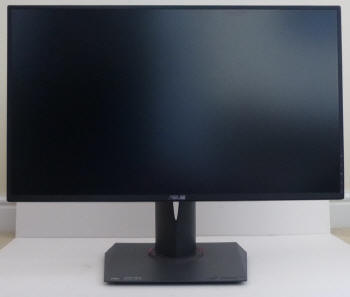

Above:
front views of the screen. Click for larger versions
The PG278Q comes in an all black design,
with matte plastics used for the bezel, stand and base. It looks very
attractive and sleek we have to say, a well designed product for sure.
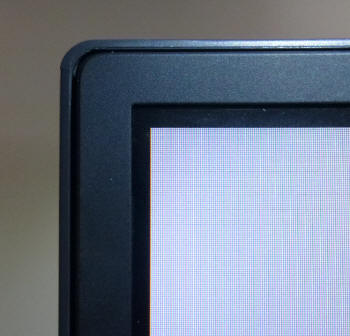
Above:
bezel and edges around the panel. Click for larger version
There is a very
thin bezel around the panel. The specs like to talk about a 6mm wide bezel
which is a little misleading, but not far off. The plastic bezel part
along the sides is 6mm thick, but then there's also an outer plastic edge
and also an "inner bezel" before you get to the actual image on the panel.
Overall there is about 10mm of black edge from the very outside of the
screen to where the image on the panel starts. In practice it still looks
and feels very thin. The lower edge is a little thicker at about 15mm
total. There is a shiny silver Asus logo in the middle of the bottom bezel
but not other writing or model names on the screen itself. The panel sits almost
flush with the bezel as well so it feels like it's near to you as opposed
to being inset a little.
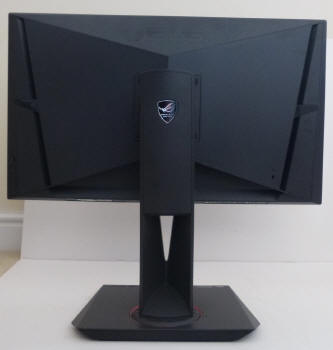

Above: rear
views of the screen. Click for larger versions.
The back of the screen is
also finished in a matte black plastic with a larger Asus logo etched into
the top, and some angled air vents for heat dissipation.

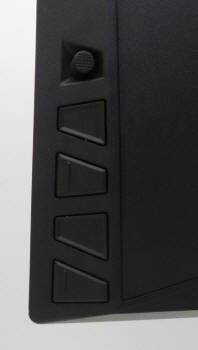
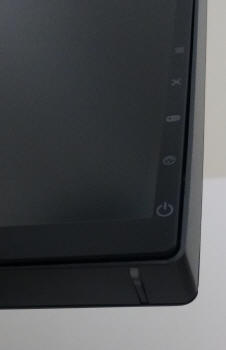
Above: view
of OSD buttons from the front (left), buttons on the back of the screen
(middle) and power LED on the bottom edge (right).
Click for larger versions
Along the lower corner of the right hand
edge are some subtle grey labels for the OSD buttons, which are located on
the back of the screen out of sight. The power LED is situated on the
bottom edge of the screen in the right hand corner, and from a normal
viewing position you can barely see it. More on the power LED in a moment.
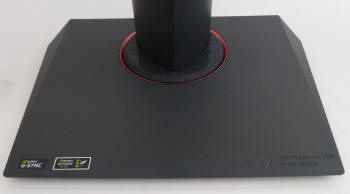
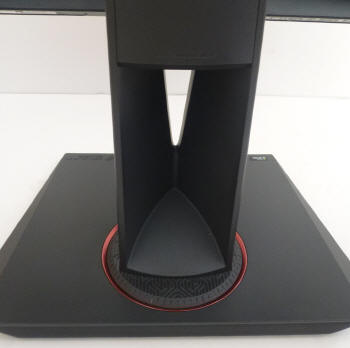
Above: view
of the base of the stand from the front and rear. Click for larger
versions
The base of the stand is quite large but
provides a sturdy and strong base for the large panel. It is made a matte
black plastic and there are NVIDIA G-sync and 3D Vision stickers attached,
and a Republic of Gamers logo etched into the plastic on the right hand
side. The monitor arm is triangular in shape where it connects into the
base. There is a hole in the arm for cable tidying as you can see from the
second photo above.
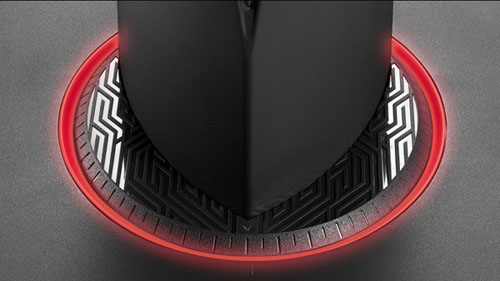
Above: view
of the "light in motion" red LED where the arm connects to the base. Click
for larger version
The monitor arm
has an attractive pattern in the plastic where it attaches into the base.
There is also a very nice looking red LED ring around the arm where it
connects to the base. This can be turned off if you want from the "light
in motion" option in the OSD, but it does add to the premium feel of the
screen. Very futuristic!
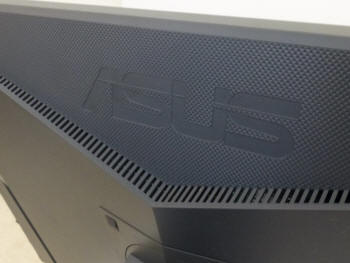
Above: view
of the back of the screen. Click for larger version
The back of the screen has a large Asus logo
etched into the plastic and a textured plastic trim. There are air vents
situated at angles on the back for heat dissipation and the overall design
looks sleek, even from the back.
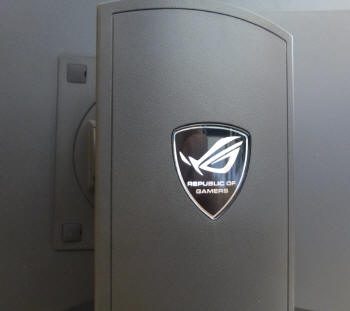
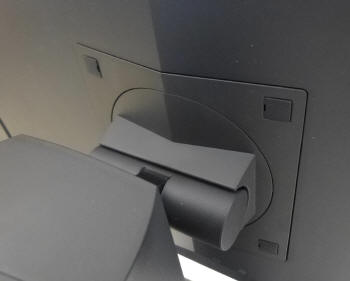
Above: ROG
logo on the back of the monitor arm, and VESA compliant attachment into
the back of the screen. Click for larger versions
The back of the monitor arm connects into the
back of the screen with a VESA 100 compliant attachment. You might note
the little rubber plugs covering each of the screw holes which was a nice
little extra touch. There is a Republic of Gamers logo on the back of the
arm as well. The stand comes attached to the screen but is easily removed
if you want to arm or wall mount the screen. If you do, you will lose the
sexy red light on the base though.

The screen offers a full range of ergonomic
adjustments from the stand.
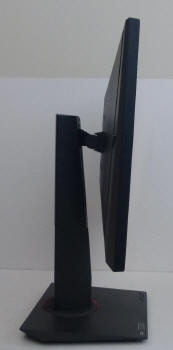
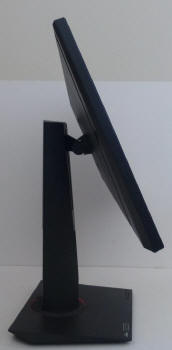
Above: full
tilt adjustment range shown. Click for larger versions
The screen offers a very good range of tilt
adjustment which is smooth and easy to move.
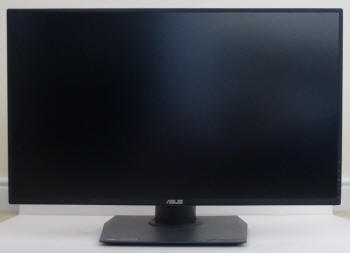
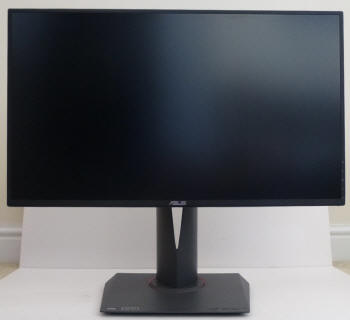
Above: full
height adjustment range shown. Click for larger versions
The height adjustment is also very easy to
operate and offers smooth movement. At the lowest adjustment the bottom
edge of the screen is ~70mm from the edge of the desk. At maximum
adjustment it is ~190mm above the desk, giving you a total 120mm
adjustment range to play with.
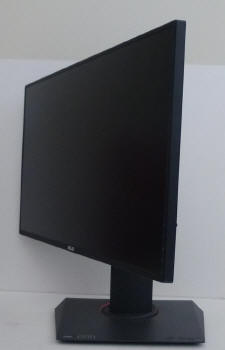
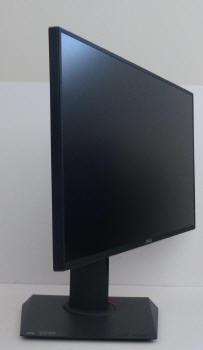
Above: full
side to side swivel adjustment shown. Click for larger versions
Side to side swivel is again smooth and very
easy to move and offers a wide adjustment range. The base of the screen
remains very stable on the desk and does not move as you move the screen
side to side.
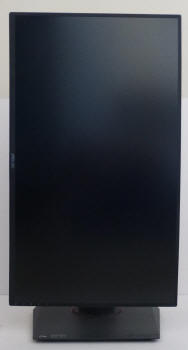
Above:
rotated portrait mode. Click for larger version
There is also a rotate function to switch
between portrait and landscape modes. This is a bit stiff to move but
provides smooth movement.
A summary of the screens ergonomic adjustments
is shown below:
|
Function |
Range |
Smoothness |
Ease of Use |
|
Tilt |
Yes |
Smooth |
Easy |
|
Height |
120mm |
Smooth |
Easy |
|
Swivel |
Yes |
Smooth |
Very easy |
|
Rotate |
Yes |
Smooth |
Stiff |
|
Overall |
Full range of adjustments,
tilt, height and swivel all very smooth and easy to use. |
The materials were of a very good standard and
build quality felt sturdy and strong. There was no audible buzzing noise
from the screen even when conducting specific tests which can often identify
buzzing issues. The whole screen remained very cool even during prolonged use
as well which was pleasing, but the power brick did get pretty warm.
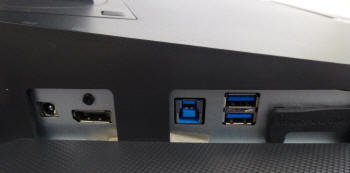
Above: view of connections on the back of the screen. Click for larger version
The back of the screen features the connections.
There is a connection for the power lead here, along side the single video
interface, a DisplayPort connection. There is then the USB 3.0 upstream port
and 2x USB 3.0 downstream ports. There's also a service connection shown on
the far right hand side which isn't useable to the user.
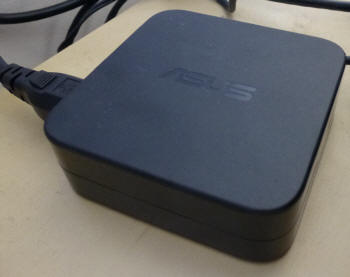
Above: external
power supply. Click for larger version


OSD Menu



Above: view
of OSD buttons from the front (left), buttons on the back of the screen
(middle) and power LED on the bottom edge (right).
Click for larger versions
The OSD menu is accessed through 4 pressable
buttons and a small joystick (also pressable) which are located on the back
right hand edge of the screen, as viewed from the front. The labels for the
buttons are located on the front bezel in a subtle grey font as shown above. The
power LED is located on the bottom edge of the screen, barely visible from a
normal viewing position. The power button glows a different colour
depending on the mode you are in which is a nice touch:
|
Power LED colour |
Screen status |
|
White |
On |
|
Amber |
Standby |
|
Off |
Off |
|
Red |
G-sync |
|
Green |
3D |
|
Yellow |
ULMB |
On another note the
screen has an incredibly fast on/off time when pressing the power
button. It is almost instantaneous in fact which was impressive.
Pressing the top OSD
button (the joystick) brings up the main OSD which we will look at in a
moment. The second button from the top exits whatever option you're
looking at.
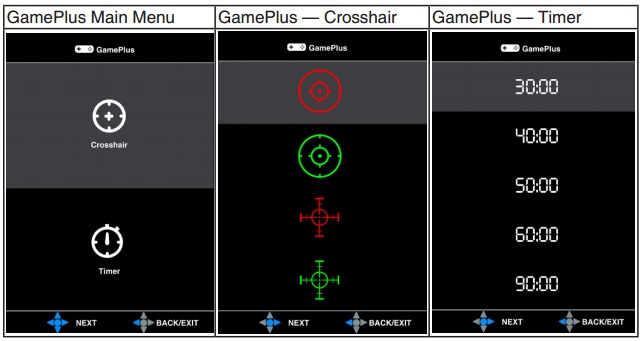
The third button down (with the small game
controller logo) is a quick access to the "game plus" menu. This gives
you options to display a crosshair or timer on the screen. You can
choose the colour and type of crosshair as shown above, and the length
of the timer. The GamePlus function provides a toolkit and creates a
better gaming environment for users when playing different types of games. In
addition, Crosshair function is specially designed for new gamers or beginners
interested in First Person Shooter (FPS) games.

The fourth button down is quick access to the
"turbo" menu, allowing you to quickly switch between different refresh
rates if you need to.
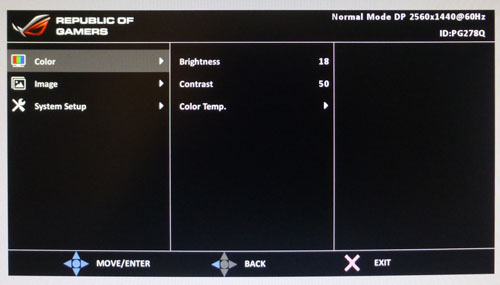
Pressing the small
joystick pops up the main menu as shown above. This is split into 3
sections down the left hand side, with the relevant options for each
section then shown on the right.
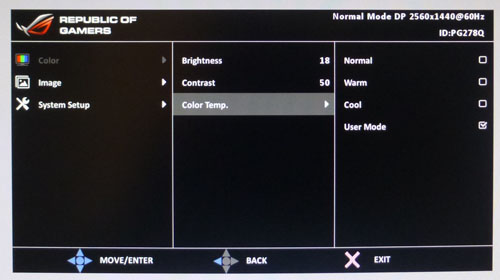
The 'color' menu gives
you access to the brightness, contrast and color temp modes as shown
above. There are no preset modes available on this screen at all which
is a bit of a shame, as it might have been nice to have some options so
you could have different settings for gaming, every day use, movies etc.
Again this is firmly a gaming screen so perhaps it was intended to be
set up purely for gaming all the time.
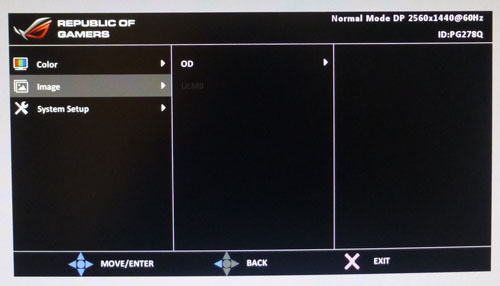
The 'image' section
allows you to control the
overdrive setting through the "OD" option.
There is also access to the
ULMB mode (greyed out here in this photo example) from this section.
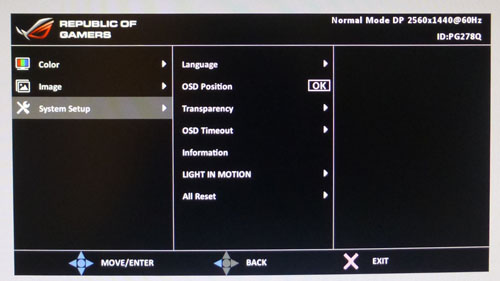
The final 'system
setup' section gives you control over a few things relating to the OSD
itself. You can turn off or on the red "light in motion" LED trim on the
bottom of the stand here if you want.
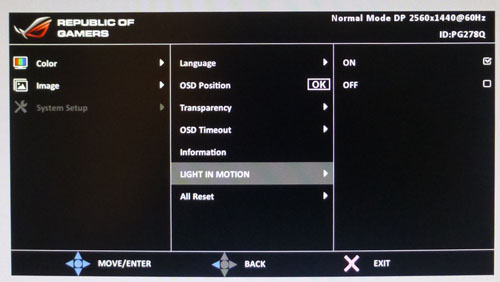
The menu doesn't offer
many options really. It is easy to navigate and the little joystick is
very intuitive and simple to operate. We liked the layout and
navigation. No issues here really, although it just felt a little
limited in options.

Power Consumption
In terms of power consumption the manufacturer
lists <90.0W maximum usage and less than 0.5W in standby. We carried out our normal tests to
establish its power consumption ourselves.
|
 |
|
State and Brightness
Setting |
Manufacturer Spec (W) |
Measured Power Usage
(W) |
|
Default (100%) |
<90.0 |
51.6 |
|
Calibrated (20%) |
- |
24.6 |
|
Maximum Brightness (100%) |
- |
51.6 |
|
Minimum Brightness (0%) |
- |
19.7 |
|
Standby |
<0.5 |
0.5 |
|
We tested this ourselves and found that out of the
box the screen used 51.6W at the default 100% brightness setting. Considering
this is the maximum brightness setting the additional power draw for the
specified 90.0W consumption must be based on having other things connected to
USB. Once calibrated the screen reached 24.6W consumption. When the screen was
on standby it used 0.5W of power. We have plotted these results below compared
with other screens we have tested. The consumption is very comparable to other
W-LED backlit displays, with wide gamut GB-r-LED units like the Dell U2713H
using slightly more (comparing calibrated states).


Panel and Backlighting
|
Panel Manufacturer |
AU Optronics |
Colour Palette |
16.7 million |
|
Panel Technology |
TN Film |
Colour Depth |
8-bit |
|
Panel Module |
M270Q002 V0 |
Colour space |
Standard gamut / sRGB |
|
Backlighting Type |
W-LED |
Colour space coverage (%) |
~72% NTSC, sRGB |
Panel Part and Colour Depth
The Asus ROG Swift PG278Q utilises a
AU Optronics M270Q002 V0 TN Film panel which is
capable of producing 16.77 million colours. This is achieved according to Asus'
specs through a true
8-bit colour depth as opposed to Frame Rate Control (FRC) being needed. That is
quite a rare thing in the TN Film panel market, and it is designed to be a
premium grade TN Film panel, not like your normal TN Film offering. We have not
seen the full panel spec sheet to confirm this incidentally. It is also
the first 2560 x 1440 TN Film panel on the market, not to mention the first 2560
x 1440 of any panel technology to natively support 120Hz and 144Hz refresh
rates.
The panel is confirmed when dismantling the screen
as shown:
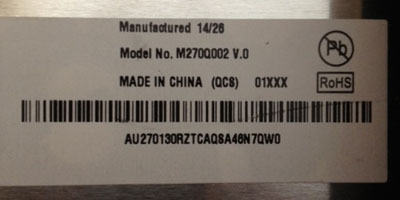
Screen
Coating
The
screen coating on the PG278Q is a medium anti-glare (AG) offering. It isn't a
semi-glossy coating, and isn't as light as some modern IPS type panels either.
It's in keeping with other TN Film panels we've tested really. Thankfully it isn't a heavily grainy coating like some
old IPS
panels feature, although there is some graininess noticeable sometimes. It
retains its anti-glare properties to avoid too many unwanted reflections of a
full glossy coating, but does not produce an too grainy or dirty an image that
some thicker AG coatings can. There were no cross-hatching patterns visible on
the coating
Backlight Type and Colour Gamut
The screen uses a White-LED (W-LED) backlight unit
which has become very popular in today's market. This helps reduce power
consumption compared with older CCFL backlight units and brings about some
environmental benefits as well. The W-LED unit offers a standard colour gamut
which is approximately equal to the sRGB colour space. We do not have the exact
colour space coverages but Asus advertise a 72% NTSC gamut. Anyone wanting to work with wider colour spaces would need to consider wide
gamut CCFL screens, or perhaps the newer range of GB-r-LED displays available
now. If
you want to read more about colour spaces and gamut then please have a read of
our
detailed article.
Backlight
Dimming and Flicker
We tested the screen to establish the methods used
to control backlight dimming. Our in depth article talks in more details about a
common method used for this which is called
Pulse Width Modulation (PWM). This in itself gives cause for concern to some
users who have experienced eye strain, headaches and other symptoms as a result
of the flickering backlight caused by this technology. We use a photosensor +
oscilloscope system to measure backlight dimming control
with a high level of accuracy and ease. These tests allow us to establish
1) Whether PWM is being used to control the
backlight
2) The frequency and other characteristics at which this operates, if it is used
3) Whether a flicker may be introduced or potentially noticeable at certain
settings
If PWM is used for backlight dimming, the higher
the frequency, the less likely you are to see artefacts and flicker. The duty
cycle (the time for which the backlight is on) is also important and the shorter
the duty cycle, the more potential there is that you may see flicker. The other
factor which can influence flicker is the amplitude of the PWM, measuring the
difference in brightness output between the 'on' and 'off' states. Please
remember that not every user would notice a flicker from a backlight using PWM,
but it is something to be wary of. It is also a hard thing to quantify as it is
very subjective when talking about whether a user may or may not experience the
side effects.
100%
50%
0%



This oscilloscope tests confirm that at all
brightness settings a Direct Current (DC) method is used for backlight dimming,
and Pulse Width Modulation is not used at all. The screen can be classified as
flicker free as a result which is great news.
|
Pulse Width
Modulation Used |
No |
|
Cycling
Frequency |
n/a |
|
Possible
Flicker at |
|
|
100% Brightness |
No |
|
50% Brightness |
No |
|
0% Brightness |
No |
For an up to date list of all flicker-free (PWM free) monitors please see our
Flicker Free Monitor Database.

Contrast
Stability and Brightness
We wanted to see how much variance there was in
the screens contrast as we adjusted the monitor setting for brightness.
In theory, brightness and contrast are two independent parameters, and good
contrast is a requirement regardless of the brightness adjustment.
Unfortunately, such is not always the case in practice. We recorded the
screens luminance and black depth at various OSD brightness settings, and
calculated the contrast ratio from there. Graphics card settings were left at
default with no ICC profile or calibration active. Tests were made using an
X-rite i1 Display Pro colorimeter. It should be noted that we used the
BasICColor calibration software here to record these, and so luminance at
default settings may vary a little from the LaCie Blue Eye Pro report.
|
OSD
Brightness |
Luminance
(cd/m2) |
Black
Point (cd/m2) |
Contrast
Ratio
( x:1) |
|
100 |
384.95 |
0.38 |
1013 |
|
90 |
353.83 |
0.35 |
1011 |
|
80 |
323.45 |
0.32 |
1011 |
|
70 |
293.23 |
0.29 |
1011 |
|
60 |
261.38 |
0.26 |
1005 |
|
50 |
228.70 |
0.23 |
994 |
|
40 |
195.74 |
0.20 |
979 |
|
30 |
159.71 |
0.16 |
998 |
|
20 |
125.68 |
0.13 |
967 |
|
10 |
88.68 |
0.09 |
985 |
|
0 |
51.58 |
0.05 |
1032 |
|
Total Luminance Adjustment Range
(cd/m2) |
333.37 |
Brightness OSD setting controls backlight? |
 |
|
Total Black Point
Adjustment Range (cd/m2) |
0.33 |
|
Average Static Contrast Ratio |
1001 |
PWM Free? |
 |
|
Recommended OSD setting for 120 cd/m2 |
18 |
The brightness control gave us a very good range
of adjustment. At the top end the maximum luminance reached 384.95
cd/m2 which was
very high, and even slightly more than the specified maximum brightness of 350 cd/m2
from the manufacturer. There was a large 333 cd/m2 adjustment range
in total, and so at the minimum setting you could reach down to a low luminance
52 cd/m2.
This should be adequate for those wanting to work in darkened room conditions
with low ambient light. A setting of 18 in the OSD menu should return you a
luminance of around 120 cd/m2 at default settings.

We have plotted the
luminance trend on the graph above. The screen behaves as it should in this
regard, with a reduction in the luminance output of the screen controlled by the
reduction in the OSD brightness setting. This is a linear relationship as you
can see from the line. It should be noted that the brightness regulation is controlled
without the need of
Pulse Width Modulation using a Direct Current (DC) method for all settings
between 100 and 0% and so the screen
is flicker free.

The average contrast ratio of
the screen was very good for a TN Film panel at 1001:1. This was stable across
the brightness adjustment range as shown above.

Testing
Methodology
An
important thing to consider for most users is how a screen will perform out of
the box and with some basic manual adjustments. Since most users won't have
access to hardware colorimeter tools, it is important to understand how the
screen is going to perform in terms of colour accuracy for the average user.
We
restored the graphics card to default settings and disabled any previously active
ICC profiles and gamma corrections. The screen was tested at default factory settings, and analysed using
an
X-rite i1
Pro Spectrophotometer (not to be confused with the i1 Display Pro
colorimeter) combined with
LaCie's Blue Eye Pro software suite. An X-rite i1 Display Pro colorimeter was
also used to verify the black point and contrast ratio since the i1 Pro
spectrophotometer is less
reliable at the darker end.
Targets for these tests are as follows:
-
CIE Diagram - validates the colour space
covered by the monitors backlighting in a 2D view, with the black triangle representing the
displays gamut, and other reference colour spaces shown for comparison
-
Gamma - we aim for 2.2 which is the default
for computer monitors
-
Colour temperature / white point - we aim
for 6500k which is the temperature of daylight
-
Luminance - we aim for 120
cd/m2, which is
the recommended luminance for LCD monitors in normal lighting conditions
-
Black depth - we aim
for as low as possible to maximise shadow detail and to offer us the best
contrast ratio
-
Contrast ratio - we aim
for as high as possible. Any dynamic contrast ratio controls are turned off here
if present
-
dE average / maximum -
as low as possible.
If DeltaE >3, the color displayed is significantly different from the
theoretical one, meaning that the difference will be perceptible to the
viewer.
If DeltaE <2, LaCie considers the calibration a success; there remains a
slight difference, but it is barely undetectable.
If DeltaE < 1, the color fidelity is excellent.

Default Performance and
Setup
Default settings of the screen were as follows:
|
Monitor OSD Option |
Default Settings |
|
Brightness |
80 |
|
Contrast |
50 |
|
Color Temp |
User Mode |
|
RGB |
100, 100, 100 |

Asus ROG Swift PG278Q - Default Factory Settings




|
|
Default Settings |
|
luminance (cd/m2) |
313 |
|
Black Point (cd/m2) |
0.34 |
|
Contrast Ratio |
928:1 |
Initially out of the box the screen appeared very
bright at its default 80% brightness setting which is very normal. You could
tell the screen was a normal standard gamut screen. The picture looked well
balanced and seemed to offer a very good default setup from what we could tell
with the naked eye. We went ahead and measured
the default state with the i1 Pro.

The
CIE diagram on the left of the image confirms that the monitors colour gamut
(black triangle) is roughly equal to
the sRGB colour space. There is some over-coverage in some shades or blue and
green, but not much. Default gamma was recorded at 2.2 average, leaving it with a
0%
deviance from the target which was excellent. White point was
measured at 6502k again being basically spot on to the target which
was very pleasing. The screen is by default in the 'user mode' colour temperature
setting, with RGB all set at 100 each. There are also 3 other pre-defined colour
temperature modes available. We recorded the white point at each of these
settings for reference:
Normal = 7344k
Warm = 6428k
Cool = 8679k
User Mode default = 6502k
Luminance was recorded at a very bright 313
cd/m2 which is
far
too high for prolonged general use. The screen was set
at a default 80% brightness in the OSD menu but that is easy to change of
course to reach a more comfortable setting. The black depth was 0.34 cd/m2 at this default
brightness setting, giving us a very good (for a TN Film panel) static contrast ratio of
928:1.
Colour accuracy was also very good out of the box with
a well balanced setup. Default dE average was 1.2, and maximum was 2.8. Testing
the screen with various gradients showed smooth transitions with no sign of any
banding thankfully. There was some gradation evident as you will see from most
monitors. Overall the default setup was excellent, and very impressive
considering this is a gaming screen. Gamma and white point were spot on, colour
accuracy was very good, and contrast ratio was strong. A very impressive
performance from the PG278Q.

Calibration
We used the
X-rite i1 Pro spectrophotometer combined with the LaCie Blue Eye Pro
software package to achieve these results and reports. An X-rite i1 Display Pro
colorimeter was used to validate the black depth and contrast
ratios due to lower end limitations of the i1 Pro device.
|
Monitor OSD Option |
Default Settings |
|
Brightness |
20 |
|
Contrast |
50 |
|
Color Temp |
User Mode |
|
RGB |
100, 100, 100 |

Asus ROG Swift PG278Q - Calibrated Settings

|
|
Calibrated Settings |
|
luminance (cd/m2) |
120 |
|
Black Point (cd/m2) |
0.14 |
|
Contrast Ratio |
858:1 |
We stuck with the 'user mode' color temp setting
as it would allow us to alter the RGB channels at a hardware level if we needed
them, and we also knew that this had returned us a white point of 6500k out of
the box. Adjustments were made during the process to the brightness control only
in fact, as the other settings seemed optimum already. These OSD
changes allowed us to obtain an
optimum hardware starting point and setup before software level changes would be
made at the graphics card level. We left the LaCie software to calibrate
to "max" brightness which would just retain the luminance of whatever brightness
we'd set the screen to, and would not in any way try and alter the luminance at
the graphics card level, which can reduce contrast ratio. These adjustments
before profiling the screen would help preserve tonal values and limit
banding issues. After this we let the software carry out the LUT adjustments and create an
ICC profile.

Average gamma remained at 2.2 average, and the
white point remained very close to the 6500k target. Luminance had been improved
thanks to the adjustment to the brightness control and was now being measured at
120
cd/m2. This
left us a black depth of 0.14 cd/m2 and maintained a high static
contrast ratio (for a TN Film panel) of 858:1. Colour accuracy of the resulting profile was very
good, with dE average of 0.6 and maximum of 1.3. LaCie would
consider colour fidelity to be excellent.
Testing the screen with various colour gradients
showed mostly smooth transitions. There was some slight gradation in darker tones
but no banding introduced due to the adjustments to the
graphics card LUT from the profilation of the screen which was pleasing.
You can use our settings and
try our calibrated ICC profile if you wish, which are available in
our ICC profile database. Keep in mind that results will vary from one
screen to another and from one computer / graphics card to another.

Calibration
Performance Comparisons
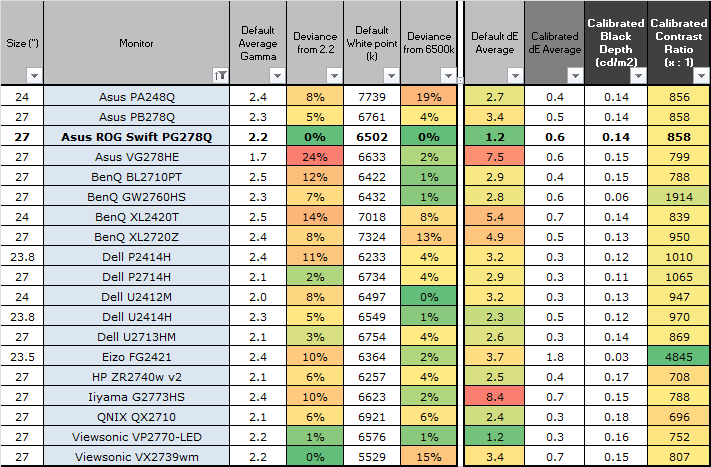
The comparisons made in this section try to give
you a better view of how each screen performs, particularly out of the box which
is what is going to matter to most consumers. When comparing the default factory
settings for each monitor it is important to take into account several
measurement areas - gamma, white point and colour accuracy. There's no point
having a low dE colour accuracy figure if the gamma curve is way off for
instance. A good factory calibration requires all 3 to be well set up. We have
deliberately not included luminance in this comparison since this is normally
far too high by default on every screen. However, that is very easily controlled
through the brightness setting (on most screens) and should not impact the other
areas being measured anyway. It is easy enough to obtain a suitable luminance
for your working conditions and individual preferences, but a reliable factory
setup in gamma, white point and colour accuracy is important and not as easy to
change accurately without a calibration tool.
From these comparisons we can also compare the
calibrated colour accuracy, black depth and contrast ratio. After a calibration
the gamma, white point and luminance should all be at their desired targets.
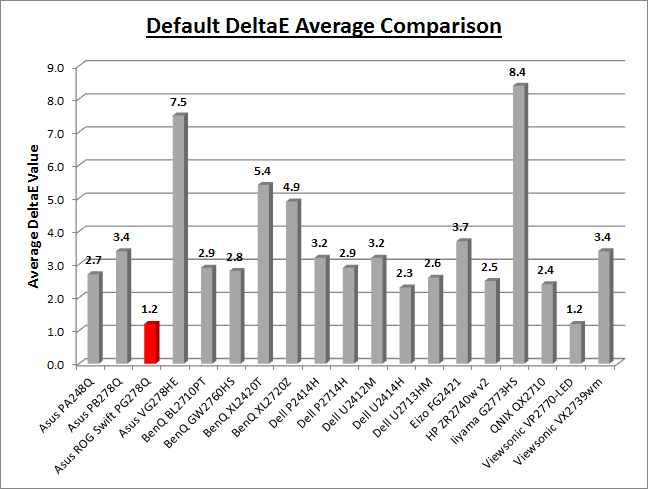
Default setup of the screen out of the box was
excellent, especially when you consider this is a gaming screen, TN Film based,
and not even aimed at colour critical work at all. Gamma and white point were
spot on to our targets. Colour accuracy was also very good with average dE of
only 1.2. Contrast ratio was strong for a TN Film matrix as well at 928:1 at
default settings. Keep in mind that there are some other limitations with TN
Film technology which mean that these panels aren't as suited as IPS for colour
critical work or professional users.
Viewing angles
are the main area of weakness and will lead to some gamma and colour tone shift
depending on your line of sight. For an average user, and certainly for gamers,
this screen did offer a very reliable default setup which we were impressed
with.
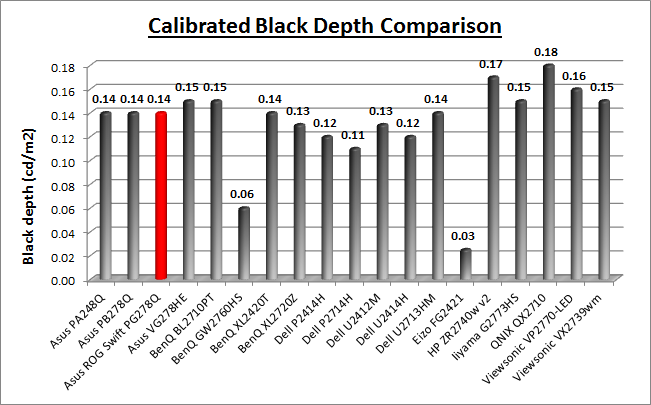
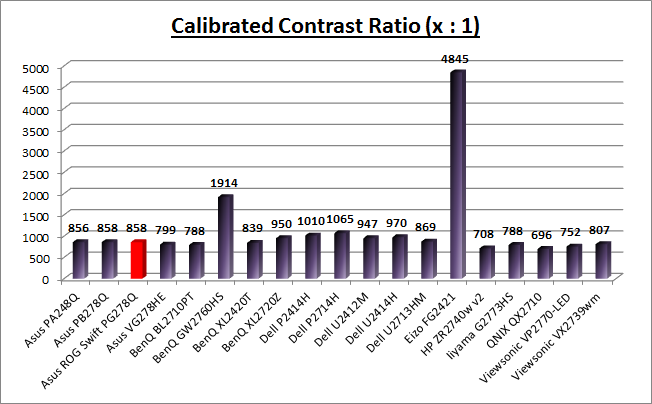
The display did do well in terms of black
depth and contrast ratio for a TN Film type panel. A contrast ratio of around 1000:1 is
a good result for this panel type so we were pleased here with the 858:1 figure.
It was higher than we'd measured from other TN Film based gaming screens like
the Asus VG278HE (799:1) and ViewSonic VX2739WM (807:1), but was only slightly
lower than the recent BenQ XL2720Z (950:1) which is obviously a key rival to
this model. Of course AMVA based screens like the BenQ BL3200PT (2464:1) and MVA
models like Eizo's own gaming screen, the FG2421 (4845:1) can offer much higher
contrast ratios still from VA panel technology.
|
Check Pricing and Buy - Direct Links
|
|
Amazon USA |
Amazon
UK |
Overclockers UK |
Amazon GER |
Amazon CAN
|
|
TFTCentral is a participant
in the Amazon Services LLC Associates Programme, an affiliate
advertising programme designed to provide a means for sites to earn
advertising fees by advertising and linking to Amazon.com, Amazon.co.uk,
Amazon.de, Amazon.ca and other Amazon stores worldwide. We also
participate in a similar scheme for Overclockers.co.uk. |

Viewing Angles

Above: Viewing
angles shown from front and side, and from above and below. Click for
larger image
Viewing angles of the PG278Q were as you might
expect from a TN Film panel. Unfortunately this panel technology is inherently
poor in this field, and so viewing angles are more restrictive than other
competing technologies like IPS, PLS and VA. Although the manufacturer will
quote a viewing angle of 170 / 160 (a classic indication that a TN Film panel is
being used by the way if in doubt), in practice there are some obvious contrast
and colour tone shifts horizontally, and especially vertically.
As you move your head from side to side in a
horizontal plane, there is a contrast shift and the image becomes darker and
introduces a slight green hue. As you move to a wider angle the image can become
more washed out as well. Vertically the fields of view are more restrictive
still. From above the image becomes pale and washed out, while from below there
is a characteristic TN Film darkening of the image. Unfortunately vertically the
viewing angles will introduce noticeable shifts in the contrast and colour tone
of the image which mean that for any colour critical work it is not really very
well suited. TN Film panels have long suffered from these restrictive viewing
angles due to the nature of their pixel structure. They are still fine for a
single user for general use and certainly the TN Film panels offer their
advantages when it comes to
pixel response
times and refresh rate for gaming. If however, you were hoping to do any colour critical or
photography work you may find these shifts in the appearance of the image
difficult. An IPS panel would probably be a wiser choice if you were looking for
a screen with much wider viewing angles but having said that you are probably
mainly interested in gaming if you are considering this screen. Remember, the ROG Swift PG278Q is specifically designed for gaming, and so you will have to
live with some of the sacrifices of TN Film to get the kind of gaming
performance that only this technology can offer.
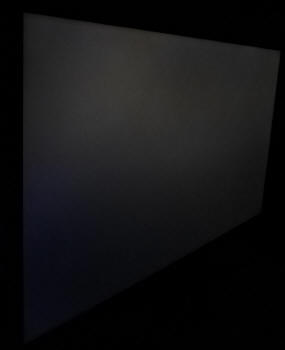
Above: View of an
all black screen from the side. Click for larger version
On a black image there is a pale grey tint
introduced to the image when viewed from a wide angle. This isn't too severe and
shouldn't present any real problems in practice. Certainly not the obvious white
glow you get from most modern IPS panels in similar situations and fairly
standard for a TN Film panel.

Panel Uniformity
We wanted to test
here how uniform the brightness and colour temperature was across the screen, as well as identify any
leakage from the backlight in dark lighting conditions. Measurements of the luminance
and colour temperature were taken at 35 points across the panel on a pure
white background. The measurements for luminance were taken using BasICColor's calibration
software package, combined with an X-rite i1 Display Pro
colorimeter with a central point on the screen calibrated to 120 cd/m2. Measurements for colour temperature (white point) were taken using
BasICColor software and the i1 Pro spectrophotometer which can more accurately
measure the white point of different backlighting technologies. The below uniformity diagram shows the difference, as a percentage,
between the measurement recorded at each point on the screen, as compared with the
central reference point.
It is worth
noting that panel uniformity can vary from one screen to another, and can depend
on manufacturing lines, screen transport and other local factors. This is only a
guide of the uniformity of the sample screen we have for review.

Uniformity of Luminance
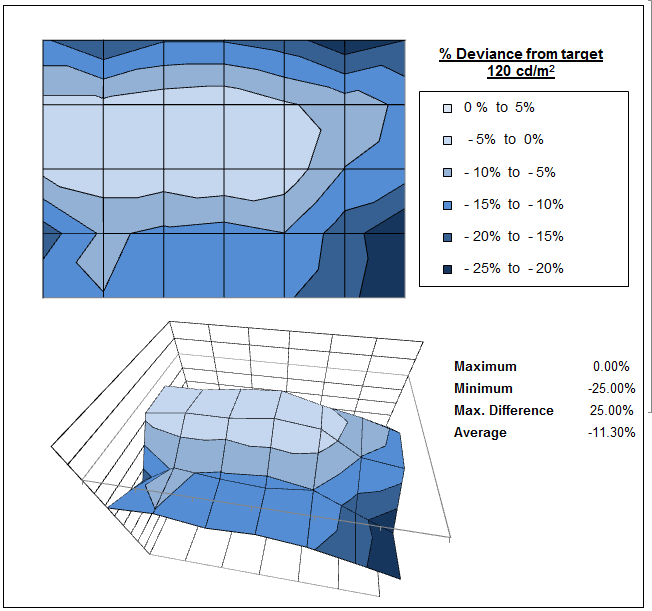
The luminance uniformity of the screen was
moderate. There seemed to be some imbalance
along the top edge and right hand side. The luminance dropped in these
regions by 25% maximum down to 96
cd/m2
in the most extreme example. The central and lower regions of the screen
were more uniform, and in day to day use you wouldn't really spot any of the
brightness variation in the other areas to be honest. Around 43% of the
screen was within a 10% deviance of the centrally calibrated point.

Backlight Leakage
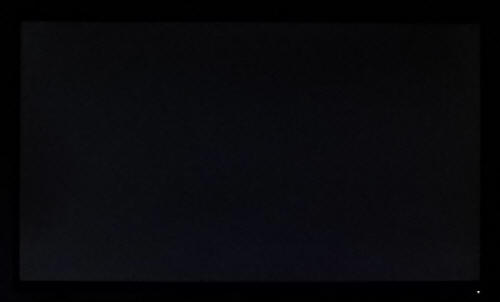
Above: All black screen in a darkened room. Click for larger version
As usual we also tested the screen with an all
black image and in a darkened room. A camera was used to capture the result.
There was no obvious backlight bleeding detectable to the naked eye at all. The camera
picked up some very slight clouding along the bottom edge, but nothing
you should notice in day to day use at all, and hard to spot with the naked eye. A very good result in terms
of backlight bleed here.

General and Office Applications
The PG278Q feature a large 2560 x 1440 WQHD
resolution which is only just a little bit less vertically than a 30" screen.
The pixel pitch of 0.233 mm is very small as a result, and by comparison a
standard 16:10 format 24" model has a pixel pitch of 0.270mm and a 30" model has
0.250mm. These ultra-high resolution 27" models offer the tightest pixel pitch
and therefore the smallest text as well. We found it quite a change originally
coming from 21.5 - 24" sized screens, even those offering quite high resolutions
and small pixel pitches. Some users may find the small text a little too small
to read comfortably, and we'd advise caution if you are coming from a 19" or 22"
screen for instance where the pixel pitch and text are much larger. The extra
screen size takes some getting used to over a few days as there really is a lot
of room to work with but once you do, it's excellent.
The massive resolution is really good for office
and general use, giving you a really big screen area to work with. It is a
noticeable upgrade from a 24" 1920 x 1200 resolution, and it's good to see
the manufacturer
have opted to stick with the high res panel here rather than reverting to some
other 1920 x 1200 / 1920 x 1080 res panel as you may find in other 27" models.
For those wanting a high resolution for CAD, design, photo work etc, this is a
really good option. The image was very sharp and crisp and text was very clear.
With its
WQHD display, you enjoy 77% more desktop space than a full HD screen to spread
out your windows and palettes. The thin bezel design and the way the panel is
basically flush with the edge of the screen mean that the PG278Q could be easily
integrated into a multi-screen set up, and would look very nice indeed.
The moderate AG coating of the TN Film panel is
not a big issue and doesn't produce any major graininess to the image like some
aggressive AG solutions can. It is however not semi-glossy or "light" so there
is some graininess evident on white backgrounds in office applications.
The text does appear very sharp and crisp though and the image quality is
excellent. The limited viewing angles of the TN Film panel technology are
perhaps the screens main weakness, meaning that you will notice colour and
contrast shifts if you deviate from a head on view of the screen. This may be
problematic if you are doing any colour work, or trying to view content from
different positions.
However, this model is firmly a gaming screen so we doubt many people would be
considering doing colour critical work on it anyway. That is in no way its
intended use, so we won't penalise the screen too much for using a TN Film
panel. The default setup was excellent with a reliable white point and gamma
setup, good colour accuracy and a strong contrast ratio.
The brightness
range of the screen was also very good, with the ability to offer a luminance
between a very high 385 and a nice and low 52 cd/m2. This should mean
the screen is perfectly useable in a wide variety of ambient light conditions,
including darkened rooms. A setting of ~18 in the OSD brightness
control should return you a luminance close to 120 cd/m2. The
backlight
regulation is controlled without the need for PWM which is excellent news
and so all brightness settings offer a flicker-free image. For every day use
(non gaming) you will want to ensure the ULMB mode is disabled as that will
introduce a deliberate screen flicker/strobe which can be distracting in static
content.
There was no
audible buzzing from the screen, even when specifically looking for it using
test images with a large amount of text at once. The screen remains cool even
during prolonged use. There are no preset modes offered by this screen so you
will have to adjust the main mod to your liking. This might mean you need to
change the brightness often when switching between normal use (where you want it
around 120 cd/m2) and gaming (where you might want it brighter). The
OSD control joystick is intuitive and changes in the brightness setting can be
achieved quickly and easily at least if need be.
The only
additional extra offered by the screen is the 2x USB 3.0 ports. Nice to see the
latest generation included, and having USB ports available is certainly a good
thing. It might have been nice if these were located on the side of the screen
for easy access. There are no further extras like ambient light sensors, human
motion sensors, card readers or integrated speakers on this model. The stand
also offers a wide range of adjustments which are very easy and smooth to move.

Above: photo of
text at 2560x 1440 (top) and 1920 x 1080 (bottom)
The screen is designed to run at its native
resolution of 2560 x 1440 and at a 60Hz recommended refresh rate. However, if
you want you are able to run the screen outside of this resolution. We tested
the screen at a lower 1920 x 1080 resolution to see how the screen handles the
interpolation of the resolution, while maintaining the same aspect ratio of
16:9. At native resolution the text was very sharp and crisp as you can see from the top
photograph. When you switch to a lower resolution the text is larger of course
but still reasonably clear with only low amounts of overlap between pixels. The
screen seems to interpolate the image well although you of course lose a lot of
desktop real-estate running at a lower resolution.

Gaming Introduction

The Asus ROG Swift PG278Q is of course exclusively
designed as a gaming screen. Asus make no apologies for this, it's a gaming
screen and a damn good one at that. As we've mentioned already it is branded
with the Republic of Gamers (ROG) name and so carries a high end design and spec
for gaming. Their press material states:
"Before the development of our ROG products, we
seek
feedback from pro gamers to create the gaming features
that really help them win. ASUS ROG is sponsoring two
League of Legends® (LoL) professional gaming teams,
Taipei Assassins (TPA) and Taipei Snipers (TPS), that
compete on the international stage. The new cooperation
between ROG, TPA and TPS, is intended to shine a light on
Taiwan’s outstanding gaming talent and hardware
prowess, and its ability to achieve outstanding results on
the world stage.
ROG is a long time supporter of worldwide eSports teams
and their participation in gaming tournaments worldwide,
with ROG gaming gear the preferred choice for many of
the world’s best players.
Commenting on ROG’s latest sponsorship, TPA captain
BeBe said: “The range of ROG gaming accessories not
only has powerful performance, its smooth rendering and
stability are also stunning. Team members will be fearless
against strong opponents from around the world, and
able to wipe out the enemies first. This is also one of the
most important reasons why we choose ASUS ROG as our
comrade.”
Graphics Card Support
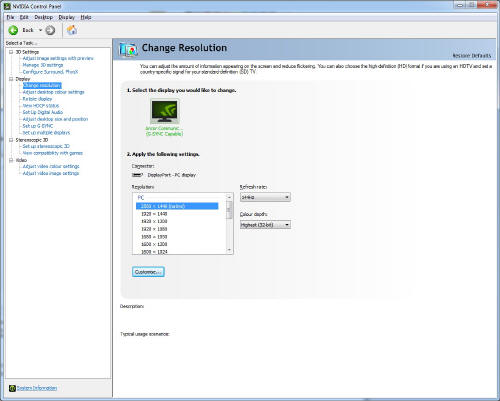
To make the most of the ROG Swift PG278Q you will
want a suitable NVIDIA graphics card. The screen is designed in conjunction with
NVIDIA and certain features including 3D Vision,
G-sync and
the Ultra Low
Motion Blur (ULMB) mode only work with NVIDIA GPU's. You will need a
graphics card from their range which supports G-sync, from the list provided on
NVIDIA's website. You will also need to ensure that the graphics card has a
DisplayPort output since the screen only has a single DisplayPort input. A lot
of NVIDIA's graphics cards seem to omit this connection type (as it's more of an
AMD connection), but some versions of their compatible cards do offer it. You
can't unfortunately use regular and widely available DVI to DisplayPort adapters
as they don't work when taking DVI output from the graphics card to DP input in
the monitor. There may be some "active" adapters which could overcome this, but
that might be hit and miss. Ensuring you have a suitable NVIDIA card with DP out
will make life much easier. If you have an older NVIDIA card with DP output
which does not support G-sync, you can still run the screen as normal. You
should be able to achieve the 144Hz refresh rate but you wouldn't be able to use
G-sync or ULMB which are linked to one another and only available on the more
modern G-sync supporting cards. On another note, you might find different
DisplayPort cables give you different results. Some we had lying around our lab
didn't seem to work very well, but you can just use the bundled cable anyway
which should be fine.
It should be noted that the screen can also be
used from AMD graphics cards, again as long as you have a DisplayPort output. We
had some issues though with achieving the maximum refresh rate on one of our
test machines (AMD 7800 series). It seemed to accept up to 100Hz without issue,
but 120 and 144Hz would return a "no signal found" message. Results
may vary from one setup to another. Again, you'd
probably have an NVIDIA card anyway if you were going to buy this screen since a
lot of what you're paying for is the G-sync / ULMB features. These refresh rates
worked straight away with our test NVIDIA GTX 780 card without issue. You will
see from the screenshot above that the screen was detected as G-sync compatible
as well.
Operating Modes and Graphics Card
Considerations
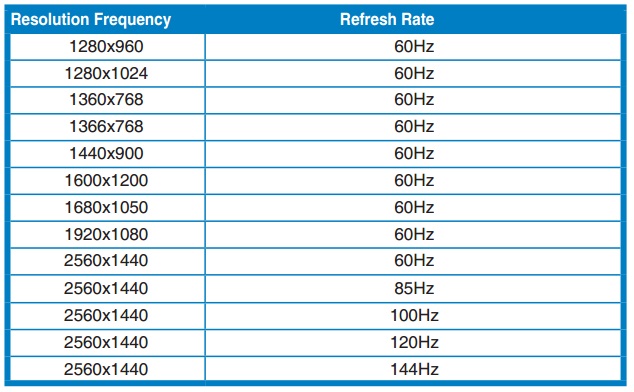
Keep in mind of course that this is the first 2560
x 1440 resolution gaming screen on the market, and the first 2560 x 1440 panel
to natively support refresh rates above 60Hz. The above table from the PG278Q
manual explains the supporting operating modes of the monitor. As you can see,
you can run at native resolution at 60, 85, 100, 120 and 144Hz which should meet
most peoples needs. Below that there are actually limited supporting operating
modes. You can run the screen at 1920 x 1080 if you want, but only at 60Hz
maximum refresh rate according to this spec. We actually tried the screen at
1920 x 1080 and 144Hz refresh rate and it seemed to work fine, but maybe results
will vary.
We expect if you're looking at such a high end
gaming display that you will also have a pretty high end gaming PC to run it, so
2560 x 1440 at 144Hz would of course be preferable over anything else. You will
see from our forthcoming
response
time tests that the increased refresh rate has a positive impact on response
times (certainly if for some reason you had OD set to off). It also positively
impacts any visible overshoot since it refreshes the screen more often, meaning
any overshoot does not linger as long. What we are trying to say here is that we hope you have a
system powerful enough to run this screen at its intended 2560 x 1440 resolution
and 144Hz refresh rate, as really that's where you will get the optimum
performance. You do need to consider the power of your graphics card though as
there will be a big demand on your system for gaming at these kind of settings.
Fortunately though there is also the new NVIDIA
G-sync technology which will
offer you smooth gaming even at lower frame rate outputs. Read on for more
information.

Response Times
|
Quoted G2G Response Time |
1ms G2G |
|
Quoted ISO Response Time |
n/a |
|
Panel Manufacturer and
Technology |
AU Optronics TN Film |
|
Panel Part |
M270Q002 V0 |
|
Overdrive Used |
Yes |
|
Overdrive Control Available to
User |
'OD' |
|
Overdrive Settings |
Off, Normal, Extreme |
The PG278Q is rated by Asus as having a 1ms G2G response time
which indicates the panel uses
overdrive /
response time compensation (RTC) technology to boost pixel transitions
across grey to grey changes. There is user control over the overdrive impulse
within the OSD menu using the 'OD' option. The
part
being used is the
AU Optronics M270Q002 V0 TN Film panel. Have a read about response time in
our
specs section if you need additional information about this measurement.
We will first test the screen using our thorough
response time testing method. This uses an oscilloscope and photosensor to
measure the pixel response times across a series of different transitions, in
the full range from 0 (black) to 255 (white). This will give us a realistic view
of how the monitor performs in real life, as opposed to being reliant only on a
manufacturers spec. We can work out the response times for changing between many
different shades, calculate the maximum, minimum and average grey
to grey (G2G) response times, and provide an evaluation of any overshoot present
on the monitor.
We use an
ETC M526
oscilloscope for these measurements along with a custom photosensor device.
Have a read of
our response time measurement article for a full explanation of the testing methodology and reported
data.
OverDrive (OD) Setting Comparison
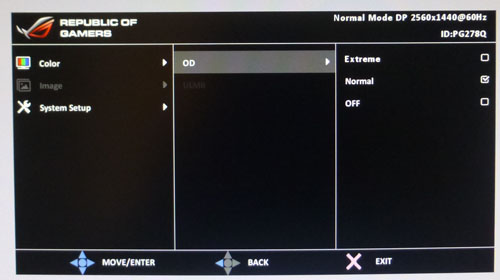
We will first of all look at the differences in
response time and overshoot under the different OD (overdrive) settings. The
OD setting is accessed via the 'image' section of the OSD menu as shown above
with options for Off, Normal and Extreme available.
OD = Off at 60Hz

First of all we tested the screen with the OD
turned to 'off' and at a refresh rate of 60Hz. This should turn off the
overdrive impulse in theory, which should leave us with slower overall pixel
response times, but hopefully no noticeable overshoot problems as a result. With
OD off the response times were very variable and it's perhaps best to look at
some of the graphs produced to explain what is happening. Remember, this is at a
60Hz refresh rate initially.
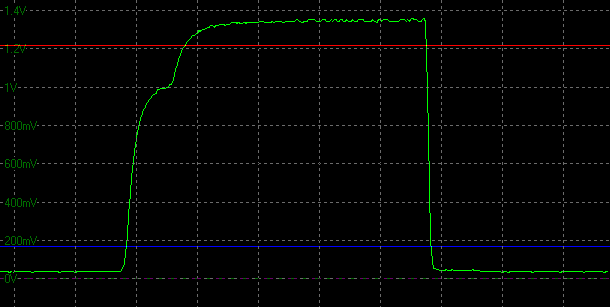
Transition: 0-255-0 (scale = 20ms)
@ 60Hz
For the transition shown above you can see that
the rise time from 0-255 is very slow, measured at 19.0ms in our table above.
That is because there seems to be a step in the brightness curve as it tries to
reach the desired brightness level (255). As a reminder, the lower flat line
represents the darker shade of the transitions (0), and the upper flat(ish) line
represents the lighter shade of the transition (255). It seems that the
brightness only reaches part of the way towards the required level, in fact only
reaching 73% of the target when it reaches the "step".
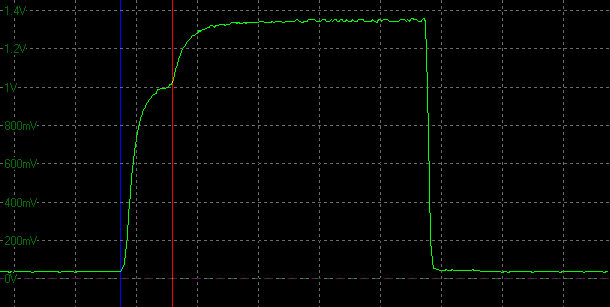
Transition: 0-255-0 (scale = 20ms)
@ 60Hz
If you look at that time it takes for the step to
complete, before the brightness starts to increase again up towards the desired
level, it is 16.667ms, which equates to 1 frame at 60Hz refresh rate. So it
seems that the pixel is driven to around 73% of its desired brightness with 1
frame, and then it takes part of a second frame to reach up to be within the
threshold for a response time measurement - that being when the brightness
reaches 90% of its target. As a result we are left with a very slow overall
response time of 19.0ms to reach within 90% of the required brightness (the rise
time). This same pattern can be seen on several of the transitions recorded in
the table
above, where a "step" occurs in the graph, and it takes 1 frame before the
brightness is then increased again towards its desired level.
On the other hand, the fall time from 255-0 is very
fast indeed, measuring only 1.4ms. There is no apparent 'stepping' of the brightness
curve in this example.
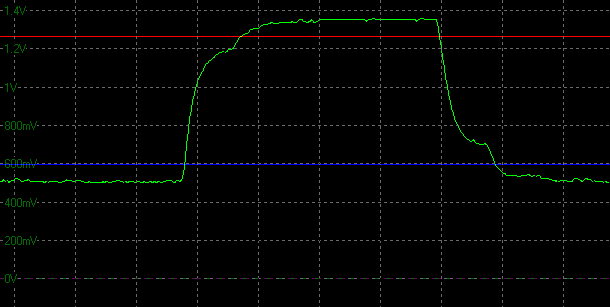
Transition: 150-255-150 (scale =
20ms) @ 60Hz
If you then look at the above transition from 150
(light grey) to 255 (white) at 60Hz refresh rate the pixel transitions are
different again. The rise time is again affected by this "step", but then so is
the fall time. This results in a slow fall time as well of 18.1ms in this
example.
It is all these variations which lead to the slow
response times for many transitions when OD is turned off and you are using a
60Hz refresh rate. This left us with an
average G2G response time of 12.2ms which was slow for a TN Film panel like
this. The fastest transitions did reach down to around 0.9ms at best which was
excellent, but the slower changes up to around 20.4ms were an issue. On the plus side,
there was no overshoot evident at all with AMA turned off, as you might hope.
We saw a very similar pixel behaviour from the
BenQ XL2720Z when we tested it as well. Of course none of this is a problem as I
doubt anyone is going to use the screen at 60Hz and with OD set to off! We are
only including it for completeness and to demonstrate the improvements then made
to response times when you boost the refresh rate up as in the next section.
OD Off at 144Hz

You can reduce the response times though because
of the way this stepping of the brightness curve is occurring. The way the
pixels behave remains unchanged, but if you increase the refresh rate you can
push more frames to the screen. The step in the brightness curve still occurs,
and it still only increases the brightness again towards the desired level at
the end of 1 frame. If you're running at 120Hz though, 1 frame now only
last 8.33ms (half the time of 60hz), so overall the time it takes to reach 90%
of the desired brightness is reduced. If you push the refresh rate up to the
maximum supported 144Hz, 1 frame now lasts 6.94ms so again the response time is
improved. The step is still there on certain transitions as it was before, but
the frame lasts a shorter amount of time so it is quicker to begin the ascent up
to the desired brightness after the step has occurred.
As you can see, at 144Hz the average G2G response
time has improved now to 6.9ms with OD off. Rise times are slower than the fall
times. As before, there is no overshoot as the OD function is off.
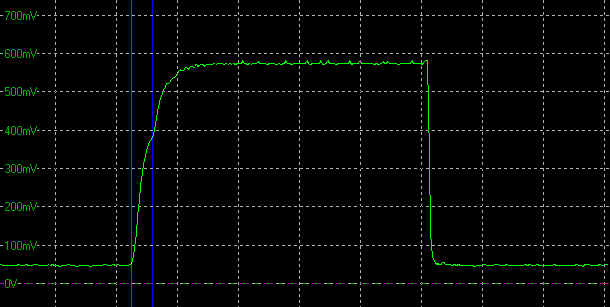
Transition: 0-150-0 (scale = 20ms)
@ 144Hz
The graph for the 0-150-0 transition above shows
that at 144Hz, the "stepping" in the brightness curve still occurs, but lasts a
much shorter time since we are now running the screen at 144Hz instead of 60Hz.
This reduces the response time measurement for the 0-150 transition from 20.4ms
to 11.0ms.
OD 'Normal'

With OD turned to the middle setting of 'Normal'
there was an obvious improvement in the response times. You will see from the
table above that we now had an average G2G response time of only 2.9ms which was
excellent, and a big improvement to what we'd seen before with OD off. The
stepping of the brightness curve had stopped and transitions were now very fast,
both for rise times and for fall times. The refresh rate doesn't have an impact
on the response times here and it is the same at 60, 120 and 144Hz.
The improved response times aren't without their
side-effects. There is some slight overshoot introduced on some transitions as
you can see. It's nothing too severe, and it's worth it because of the vastly
improved response times. In practice, moving images look sharper and smoother
and there is less apparent blur than when OD was off.
OD 'Extreme'

With OD now turned up to the maximum 'Extreme'
setting you can see that the overall response times remained very similar to the
'Normal' setting with some minor improvement. We achieved an average 2.4ms G2G
response time here although much larger overshoot was now present. The overdrive
impulse is too aggressive in this mode and it is leading to far too much
overshoot. In practice there is basically no change to responsiveness, but a
noticeable dark trail is now present across many colour transitions. The normal mode
seems optimum on this screen, and extreme should probably be avoided.
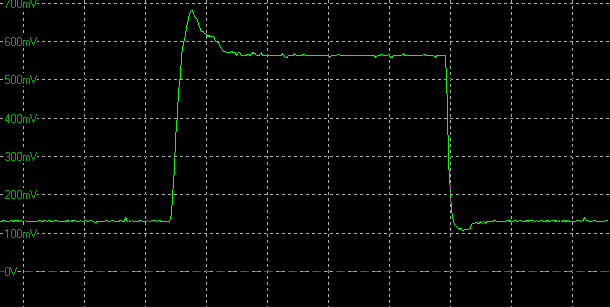
Transition: 50-150-50 (scale = 20ms)
@ 144Hz
An example shown above demonstrates the fast rise
and fall times, but there is a high overshoot on the rise time (32.8%) and some
on the fall time as well (5.4%).
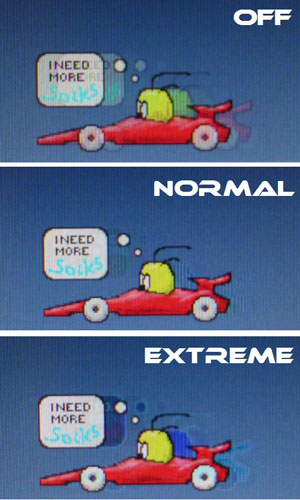
If we also carry out some subjective assessment of
the screen during gaming and with the use of the PixPerAn moving car tests, we
can also see the differences between each OD mode easily enough with the naked
eye. These images taken of the moving car test taken at 144Hz refresh rate,
supporting what we've measured with the oscilloscope as well. With OD off there
is a moderate blur to the moving image with a ghost trail detected. This is less
evident when the screen is running at 144Hz refresh rate (shown here) than when
running at 60Hz as well, and you of course then also benefit from a higher frame
rate and smoother movement. There are no noticeable overshoot artefacts with OD
set to off either. When you switch OD to 'normal' the blurring is eliminated
greatly, and you see a sharper moving image as a result. There is some very
slight dark trailing shown in the sample colour transitions used in PixPerAn
which you can see in the images. It doesn't affect every colour transition as
we've already measured in this section and in gaming it isn't overly
problematic. It is there in certain situations but the improvement in response
times and reduction in blur is well worth the sacrifice we feel. If you then
bump the OD setting up to the maximum 'extreme' setting there is not really any
noticeable improvement to the movement on the screen, but the overshoot becomes
far more noticeable. The dark trails become darker and more pronounced and there
is also some additional pale overshoot introduced behind the car. OD 'normal'
seems to be the best balance we felt in practice as well as based on our
oscilloscope tests.

More Detailed Measurements - OD = Normal
Having established that the overdrive 'normal' mode seemed to
offer the best response/overshoot balance we carried
out our normal wider range of measurements as shown below:
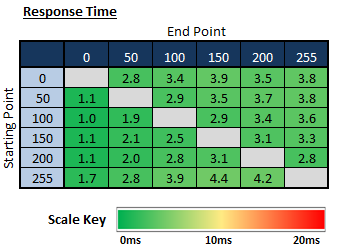 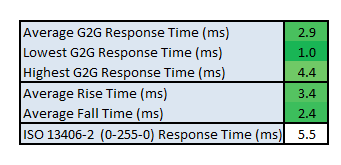
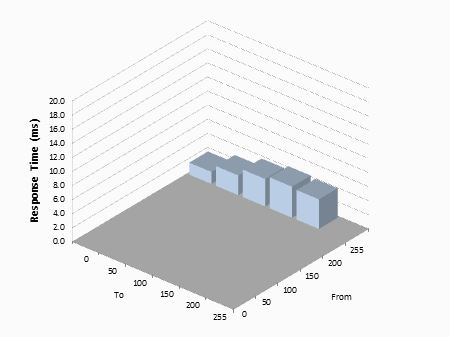
The average G2G response time was more accurately
measured at 2.9ms which was excellent overall. Rise times were slightly slower
on average (3.4ms) than fall times (2.4ms) but not much to worry about at all.
Response times were consistently low across the board, and this was a very
pleasing result, even for a modern TN Film panel.
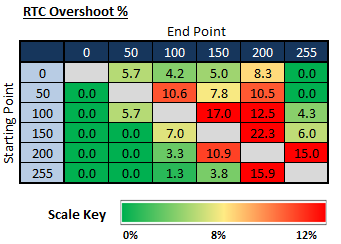
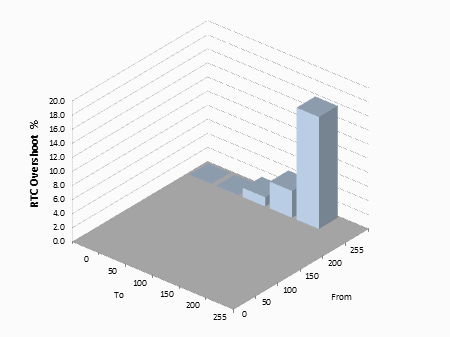
There was some slight overshoot on some
transitions but on the whole it was not too severe. Some transitions showed
quite high overshoot, but most were <10% which was pleasing. This was certainly
the best OD setting, as the higher 'extreme' setting had far more noticeable
overshoot.

Display Comparisons
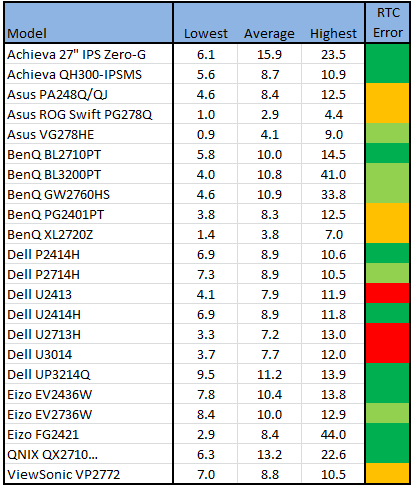
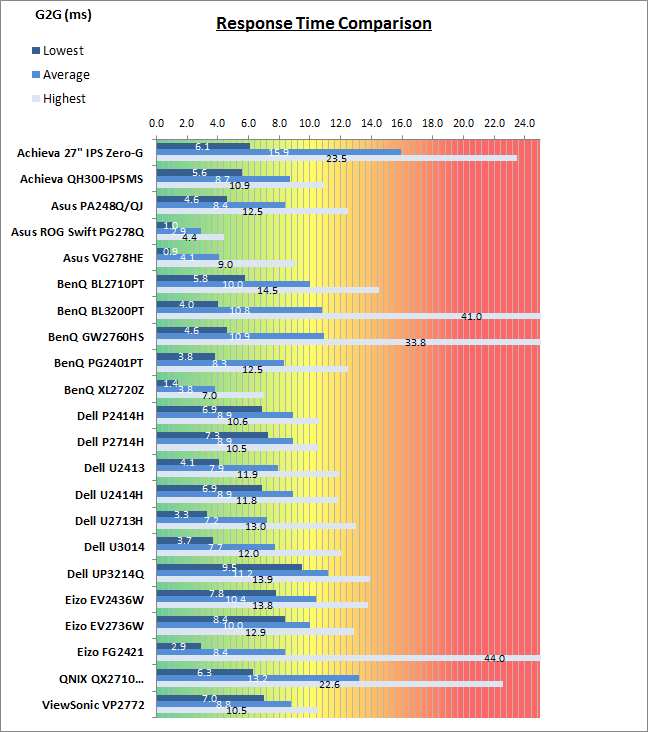
The above comparison table and graph shows you the
lowest, average and highest G2G response time measurement for each screen we
have tested with our oscilloscope system. There is also a colour coded mark next
to each screen in the table to indicate the RTC overshoot error, as the response
time figure alone doesn't tell the whole story.
The response time performance of the PG278Q is
excellent, and even a little faster than the other gaming TN Film screens we
have tested here. With an average 2.9ms G2G response time in the 'normal' OD
mode, it is slightly faster than the Asus VG278HE (4.1ms) and BenQ XL2720Z
(3.8ms) which was very impressive. There was some moderate overshoot detected in
this mode, mostly pretty minor, and nothing that should be too distracting in
game play. These TN Film panels are clearly much faster than competing
technologies, which is the reason why TN Film continues to be used for high end
gaming screens.
The screen was also tested using the chase test in
PixPerAn for the following display comparisons. As a reminder, a series of
pictures are taken on the highest shutter speed and compared, with the best case
example shown on the left, and worst case example on the right. This should only
be used as a rough guide to comparative responsiveness but is handy for a
comparison between different screens and technologies as well as a means to
compare those screens we tested before the introduction of our oscilloscope
method.

27"
1ms
G2G AU Optronics TN Film @ 144Hz (OD = Normal)
In practice the Asus PG278Q performed best with
the Overdrive setting on 'normal'. Motion blur was minimal and the moving image
looked sharp and crisp. Motion felt very fast and fluid thanks to the 144Hz
refresh rate, something which you can't really pick out with the camera. There
was some minor overshoot evident in the form of a slight dark trail behind the
moving car, but we've already established with our oscilloscope that overshoot
is fairly low, only affecting a few transitions more noticeably.

27"
1ms
G2G AU Optronics TN Film @ 144Hz (OD = Normal)

27" 4ms G2G AU
Optronics AHVA (AMA Setting = High)

27" 12ms G2G
Samsung PLS (Response Time = Advanced)

27" 8ms G2G
LG.Display AH-IPS

27" 5ms G2G
Samsung PLS (Trace Free = 40)
Firstly it is interesting to compare the PG278Q to some of the other popular 27"
models we have tested with 2560 x 1440 resolutions and IPS-type panels (IPS, PLS
and AHVA). You can
see first of all a comparison against the
BenQ BL2710PT and
ViewSonic VP2770-LED which show a more noticeable blurred image. The
Dell U2713HM
and
Asus PB278Q
are faster, but in practice cannot compete with the speed of the ROG Swift
PG278Q. The movement is clearer and smoother on the PG278Q and you also have the
massive benefit of the 144Hz refresh rate.

27"
1ms
G2G AU Optronics TN Film @ 144Hz (OD = Normal)

27" 2ms G2G Chi
Mei Innolux TN Film +144Hz (Trace Free = 60)

27" 1ms G2G
AU Optronics TN Film + 144Hz (AMA = High)

23.5" 4ms G2G
Sharp MVA + 120Hz
We've also included a comparison above against
3 other very fast 120Hz+ compatible screens we have tested. The screens shown
here are all aimed primarily at gamers and have various features and extras
which make them more suitable overall for gaming.
Firstly there is a comparison against the
Asus VG278HE with its 144Hz refresh
rate and fast response time TN Film panel. This showed very fast pixel response times and smooth movement thanks to
its increased refresh rate. You are able to reduce the motion blur even more
through the use of the LightBoost strobed backlight which we talked about in
depth in our article about
Motion Blur Reduction Backlights.
Then there is a comparison against the
BenQ XL2720Z with another very fast TN Film panel and 144Hz refresh rate.
This showed very low levels of motion blur, but some dark overshoot was
introduced as a side-effect as you can see. This seemed to be more noticeable in
these tests than on the PG278Q. This screen also includes a native
Blur Reduction mode to help eliminate further perceived motion blur.
Lastly there is the MVA based Eizo FG2421 screen
with a fast response time (especially for the panel technology being used) and
120Hz refresh rate support. There is also an additional 'Turbo 240' motion blur
reduction mode which really helps reduce the perceived motion blur in practice.
The Asus ROG Swift PG278Q performed the best out
of these gaming screens we felt. Response times were a little lower as measured
with the oscilloscope, and in practice it felt slightly faster. It too has a
native blur
reduction mode (ULMB) which we will look at shortly. One other thing to note
here is that these other screens can only support a maximum 1920 x 1080
resolution, and so there's a huge jump in resolution and image quality when
extending to a 2560 x 1440 panel in the PG278Q. Overall a very impressive
performance from the PG278Q.

G-Sync
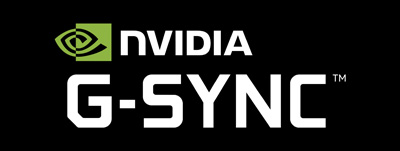
Obviously a huge part of the ROG Swift PG278Q is
the addition of NVIDIA's new G-sync technology. We thought it would be useful to
give you some background on what G-sync is and what it offers. As an introduction,
monitors typically operate
at a fixed refresh rate, whether that is 60, 120 or 144Hz. When running
graphically intense content like games, the frame rate can of course fluctuate
somewhat and this poses a potential issue to the user. There are traditionally
two main options available for how frames are passed from the graphics card to
the monitor using a feature called VSYNC, whether Vsync is turned on or off.
Vsync Overview
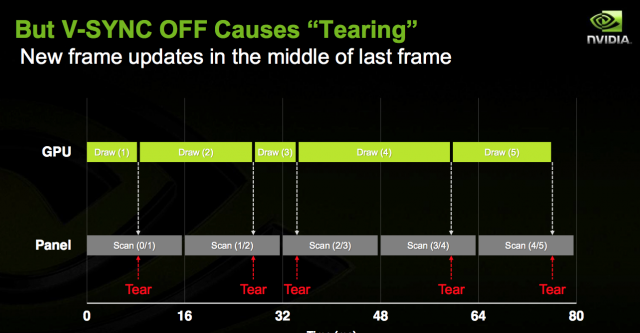
At the most basic level
‘VSync
OFF’
allows the GPU to send frames to the monitor as soon as they have been
processed, irrespective of whether the monitor has finished its refresh and is
ready to move onto the next frame. This allows you to run at higher frame rates
than the refresh rate of your monitor but can lead to a lot of problems. When
the frame rate of the game and refresh rate of the monitor are different, things
become unsynchronised. This lack of synchronisation coupled with the nature of
monitor refreshes (typically from top to bottom) causes the monitor to display a
different frame towards the top of the screen vs. the bottom. This results in
distinctive
‘tearing’
on the monitor that really bothers some users. Even on a 120Hz or 144Hz monitor,
where some users incorrectly claim that there is no tearing, the tearing is
still there. It is generally less noticeable but it is definitely still there.
Tearing can become
particularly noticeable during faster horizontal motion (e.g. turning, panning,
strafing), especially at lower refresh rates.
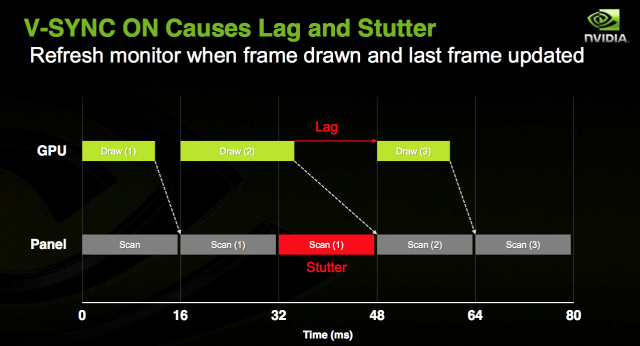
The solution to this tearing problem for many
years has been the
‘VSync
ON’
option which essentially forces the GPU to hold a frame until the monitor is
ready to display it, as it has finished displaying the previous frame. It also
locks the frame rate to a maximum equal to the monitor’s refresh rate. Whilst
this eliminates tearing, it also increases
lag
as there is an inherent delay before frames are sent to the monitor. On a 120Hz
monitor the lag penalty is half that of a 60Hz monitor and on a 144Hz
monitor is even lower. It is still there, though, and some users feel it
disconnects them from game play somewhat. When the frame rate drops below the
refresh rate of the monitor this disconnected feeling increases to a level that
will bother a large number of users. Some frames will be processed by the GPU more slowly than the monitor is able to display them. In other words the
monitor is ready to move onto a new frame before the GPU is ready to send it. So
instead of displaying a new frame the monitor displays the previous frame again,
resulting in
stutter.
Stuttering can be a major problem when using the Vsync on option to reduce
tearing.
During Vsync ON operation, there can also
sometimes be a sudden slow down in frame rates when the GPU has to work harder.
This creates situations where the frame rate suddenly halves, such as 60 frames
per second slowing down to 30 frames per second. During Vsync ON, if your
graphics card is not running flat-out, these frame rate transitions can be very
jarring. These sudden changes to frame rates creates sudden changes in lag, and this can disrupt
game play, especially in first-person shooters.
NVIDIA G-sync Variable
refresh rate solution
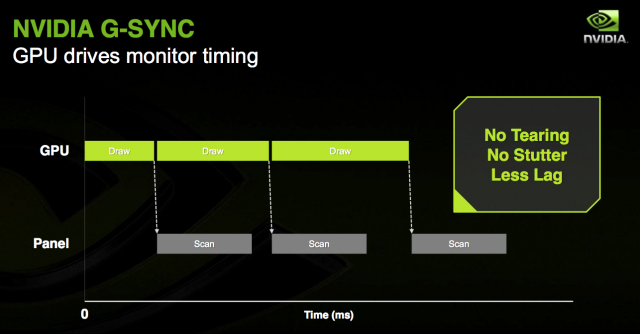
To overcome these
limitations with Vsync, NVIDIA have just introduced a new technology they have
dubbed G-sync. This technology can be integrated into monitors to allow them to
adopt a variable refresh rate, dynamically altering the monitor depending on the
graphics card output and frame rate. The frame rate of the monitor is still
limited in much the same way it is without G-SYNC, but it adjusts dynamically to
a refresh rate as low as 30Hz to match the frame rate of the game. By doing this
the monitor refresh rate is perfectly synchronised with the GPU. You don’t get
the screen tearing or visual latency of having Vsync disabled, nor do you get
the stuttering or input lag associates with using Vsync. You can get the benefit
of higher frame rates from Vsync off (within the G-sync range of 30Hz - 144Hz)
but without the tearing, and without the lag and stuttering caused if you switch
to Vsync On.
We don't want to go into too much depth about game
play, frame rates and the performance of G-sync here as we will end up moving
away from characteristics of the monitor and into areas more associated with the
operation of the graphics card and its output. G-sync is a combined graphics
card and monitor technology, but from a monitor point of view all it is doing is
supporting this feature to allow the graphics card to operate in a new way.
There are plenty of reviews and tests of G-sync online which cover the operation
of G-sync in more detail. Our friends over at
http://www.blurbusters.com/ have done some G-sync testing in various games
which is well worth a read. They've also carried out
various lag
tests which have confirmed that using G-sync doesn't seem to add any
noticeable lag, compared with running with Vsync off.
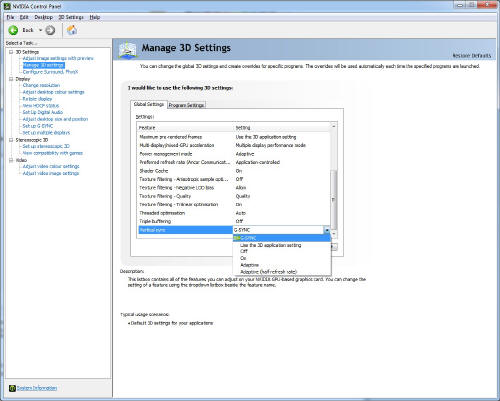
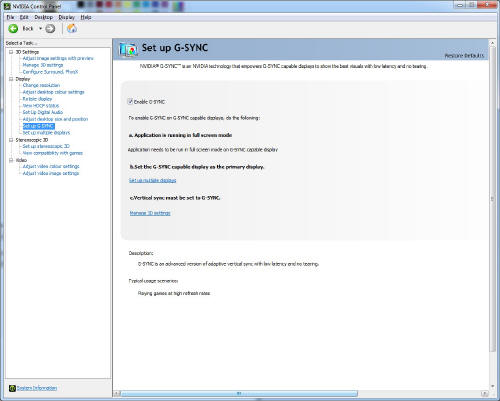
Above: G-sync
options in the NVIDIA control panel
We did run some tests using Battlefield 4 to see
how it worked ourselves. In Battlefield you will experience a lot of varying
frame rates due to the changes in scenery and the complexity of your
surroundings. Playing with G-sync enabled allowed the monitors refresh rate to
synchronise with the graphics card frame rate, and this nicely removed the
stutter we saw from using Vsync. It also meant there was no tearing like you'd
see from having Vsync off which of course is a massive bonus. We were very
impressed by the fluidity and smoothness of motion and the absence of artefacts
which can be easily detected in similar conditions when using Vsync on or Vsync
off. We'd encourage you to read some of the G-sync reviews online as they go
into a lot more detail about graphics card rendering, frame rates etc as well.
It should be noted that the real benefits of
G-sync really come into play when viewing lower frame rate content, around 45 -
60fps typically delivers the best results compared with Vsync on/off. At
consistently higher
frame rates as you get nearer to 144 fps the benefits of G-sync are not as
great, but still apparent. There will be a gradual transition period for each
user where the benefits of using G-sync decrease, and it may instead be better
to use the ULMB
feature discussed in the following section which is not available when using
G-sync. Higher end gaming machines might be able to push out higher frame rates
more consistently and so you might find less benefit in using G-sync. The ULMB
could then help in another very important area, helping to reduce the perceived
motion blur caused by LCD displays. Keeping in mind that the PG278Q features a
massive 2560 x 1440 resolution, you'd need a pretty powerful system to achieve
consistently high frame rates, so we'd encourage you to try G-sync of course to
see how it affects your gaming usage. It's nice to have both G-sync and ULMB
available to choose from certainly. Well done Asus!
For more information on G-sync from NVIDIA, please
visit their website:
http://www.geforce.co.uk/hardware/technology/g-sync
|
Check Pricing and Buy
You can
help to support TFTCentral by purchasing your display and other hardware
via our affiliate links below. This helps us earn a small referral fee for
any purchase you make and contributes towards the ongoing running of this
site. Thank you. |
|
Amazon USA |
Amazon
UK |
Overclockers UK |
Amazon GER |
Amazon CAN |

Ultra Low Motion Blur (ULMB)
The Asus PG278Q also features an integrated Blur
Reduction Backlight system, dubbed "Ultra Low Motion Blur" (ULMB). We have
already seen a lot of positive improvements in perceived motion blur from such
systems in the past. Our
in depth article from June 2013 looked at this in a lot
more detail, and tested some of the original LightBoost "hacks" to achieve a
strobed backlight and blur reduction benefits. Since then we've seen a couple of
monitors integrate a similar strobed backlight with simple user control from the
menu. The
Eizo Foris FG2421 and
BenQ XL2720Z both had useful
integrated blur reduction
modes, and the Asus ROG Swift PG278Q also features one.
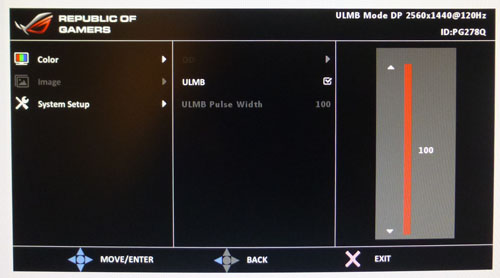
The ULMB feature is accessible from the image
section of the OSD menu as shown above. It is only available when running the
screen at 85, 100 and 120Hz modes. It is not available at 144Hz and it is also important to note that ULMB does not
work when you are using G-sync, it's one or the other. When you enable the ULMB
feature a new option appears for the "ULMB Pulse Width" as you can see from the
screenshot above. We will test that in a moment as well, but it allows you to
control the strobe length, and therefore adjust the visible persistence
somewhat. You can adjust this between 100 and 10, and as you lower the setting
the screen also becomes progressively darker as you reduce the "on" period of
the strobe. Nice to see this included as an option within the menu for those who
like to play around with the setting, much like you could do by adjusting
LightBoost levels on older models using the
"hack" method. There is no control to adjust the timing of the strobe to
impact the strobe cross-talk it can introduce, so we will have to hope that the default
timing setup is suitable.
Operation - 85Hz
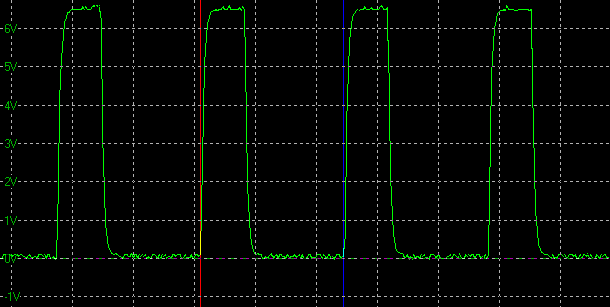
ULMB
backlight cycling, 85Hz
(scale = 5ms)
pulse width setting= 100
We measured the screen using our oscilloscope when
viewing a solid white image, with ULMB feature turned on and with
refresh rate set at 85Hz. This is the lowest refresh rate at which you can
operate the ULMB mode. As a reminder, it works at 85, 100 and 120Hz only. We
left the pulse width (strobe length) setting at 100 initially. Normally the oscillograph would show a flat straight
line when measuring a static white image (as no PWM is being used for backlight
dimming), but here the ULMB feature is cycling the backlight off and
on rapidly.
The time for each complete cycle is 11.76ms which
shows that in this case the backlight is being cycled at the same frequency as
the refresh rate, 85 times per second. The strobe is in time with the refresh
rate of 85Hz.
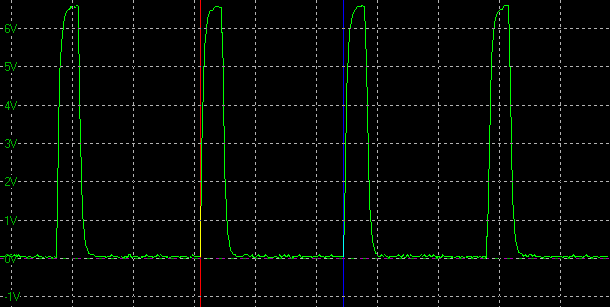
ULMB
backlight cycling, 85Hz
(scale = 5ms)
pulse width setting = 50
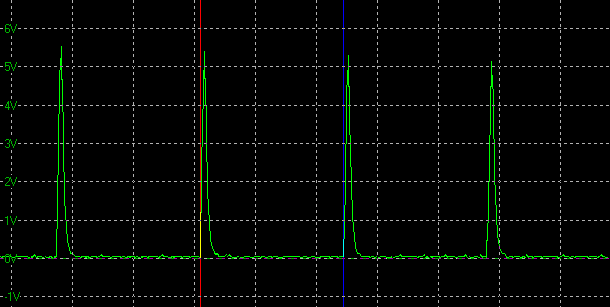
ULMB
backlight cycling, 85Hz
(scale = 5ms)
pulse width setting = 10
As you reduce the pulse width setting you are
adjusting the 'on' period of the strobe. As you reduce the setting the strobe
'on' time gets progressively shorter as you can see from the above 2 graphs, the
first at a setting of 50 and the second at a setting of 10 (the minimum setting
available). This impacts the perceived blur somewhat, with the shorter 'on'
times resulting in a clearer image. At the same time though the brightness of
the image is affected and it becomes very dark, the lower you go with the
setting. More on that in a moment. There will be a point where the user does not
see any further benefit to their eyes of reducing the strobe length further, but
you can have a play around with the setting to find your personal preference to
balance perceived motion blur and brightness of the image.
Operation - 100Hz
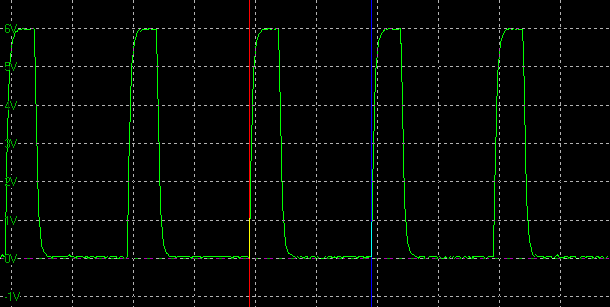
ULMB
backlight cycling, 100Hz
(scale = 5ms)
pulse width setting = 100
When running the screen at a 100Hz refresh rate
the behaviour is exactly the same. The only difference is that the strobe is now
synced with the new refresh rate, with a new strobe every 10ms (100 times per
second).
Operation - 120Hz
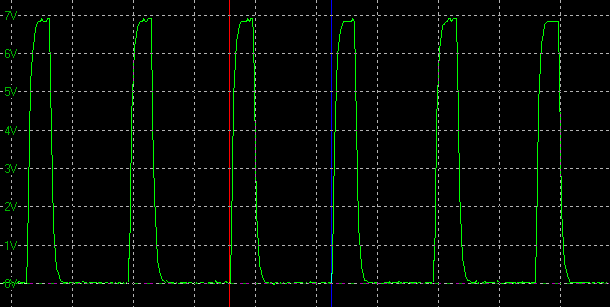
ULMB
backlight cycling, 120Hz
(scale = 5ms)
pulse width setting = 100
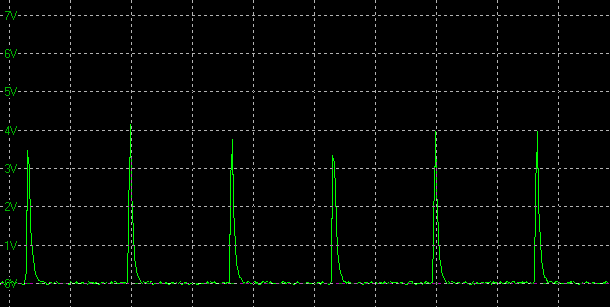
ULMB
backlight cycling, 120Hz
(scale = 5ms)
pulse width setting = 10
Again when set at 120Hz refresh rate the strobes
are in sync again, with a new strobe every 8.33ms (120 times per second). As you
can see, as you reduce the pulse width setting (strobe length) in the OSD menu,
the 'on' period gets shorter, reducing perceived motion blur, but also impacting
brightness.
Pulse Width Setting - Strobe Length
We measured the strobe length at a variety of the
Pulse Width settings, while running at the maximum 120Hz refresh rate mode. You
can adjust the setting in steps of 1 incidentally. Each complete strobe lasts a total of
8.33ms (120 strobes per second):
|
Pulse Width
Setting |
On period (ms) |
|
100 |
1.875 |
|
75 |
1.375 |
|
50 |
0.875 |
|
25 |
0.500 |
|
10 (min) |
0.250 |
Pulse Width Setting - Brightness Range
|
Pulse Width
Setting |
Luminance
(cd/m2) |
Black
Point (cd/m2) |
Contrast
Ratio
( x:1) |
|
100 |
122.67 |
0.14 |
876 |
|
75 |
92.59 |
0.11 |
842 |
|
50 |
62.3 |
0.07 |
890 |
|
25 |
31.4 |
0.04 |
785 |
|
10 (min) |
12.76 |
<0.02 |
- |
We tested the brightness output of the screen when
ULMB was turned on. You can independently control the brightness setting as well
if you want, but we left it at the default 100 and just changed the pulse width
(PW) strobe length setting to establish the brightness range when using this
option. With the PW setting at 100 the maximum achievable luminance of the
screen was a moderate 123
cd/m2. This
should be enough for a lot of uses, but you cannot get a brighter display when
using ULMB if you wanted to. This is a typical performance from a strobe
backlight anyway and represented a decent enough luminance level. As you reduce
the PW setting the luminance drops significantly, at the lowest setting probably
being far too dark for any practical use. At least you can control a reasonably
wide range here, so you can find a level which suits your needs. We suspect a
setting of 100 will probably be adequate for most normal users anyway, as the
ULMB mode certainly brings about positive improvements to the perceived motion
blur.
Brightness Range (PW at 100)
|
Brightness Setting |
Luminance
(cd/m2) |
Black
Point (cd/m2) |
Contrast
Ratio
( x:1) |
|
100 |
122.67 |
0.14 |
876 |
|
75 |
102.86 |
0.11 |
935 |
|
50 |
74.47 |
0.08 |
931 |
|
25 |
43.87 |
0.05 |
877 |
|
0 |
10.65 |
<0.02 |
- |
We also wanted to test the brightness range when
leaving PW at its default 100, and changing the brightness control of the screen
instead. The table above confirms the range available through that control.
Colour and Other Setup Characteristics
We wanted to test the impact on the setup of the
screen when enabling the ULMB feature to see whether it has a knock-on
effect to white point, gamma or colour accuracy. You can see straight away that
it impacts the luminance of the screen, which we've already looked at above.

Asus ROG Swift PG278Q - Calibrated Settings, ULMB Off

|
|
Calibrated Settings |
|
luminance (cd/m2) |
120 |
|
Black Point (cd/m2) |
0.14 |
|
Contrast Ratio |
858:1 |
Above is our calibrated state from
earlier on
in the review, with the ULMB feature turned off.

Asus ROG Swift PG278Q - Calibrated Settings, ULMB On
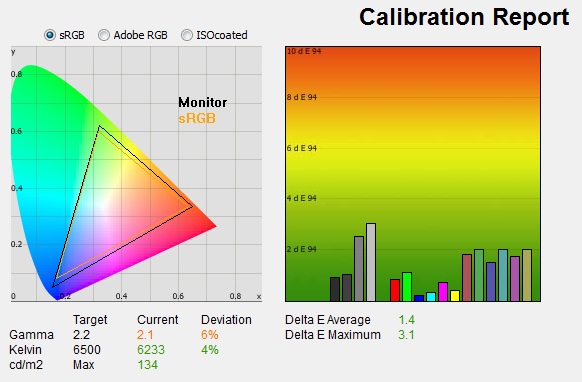
|
|
Calibrated Settings
ULMB On |
|
luminance (cd/m2) |
134 |
|
Black Point (cd/m2) |
0.15 |
|
Contrast Ratio |
888:1 |
We turned the ULMB mode on, but left the PW option
at 100 here, and with the default maximum 100 brightness as well. We left our
calibrated ICC profile active from our initial calibration to see what immediate
impact the ULMB setting had on the colour performance. The gamma and white point
were skewed slightly here, with gamma now a little lower at 2.1 average (6%
deviance), and white point being a little warmer at 6233k (4% out). The contrast
ratio remained very similar at 888:1. The colour
accuracy was also a little off with average dE of 1.4 now, maximum of 3.1. No
major impact really to the appearance of the screen of the colour rendering
other than the reduction in achievable luminance of course. This was pleasing as
we know from testing older LightBoost strobed backlight systems that they can
really impact the colours and white point of a screen when enabled.
Blur Reduction Tests
Of course the main thing we want to test is what
improvements the Blur Reduction mode offers when it comes to motion clarity and
gaming. We were pleased with the results we'd seen from LightBoost backlights
when we tested them, and also from the natively supported blur reduction
feature on other displays. So we were keen to understand if
Asus had achieved something similar here with their ROG Swift PG278Q. Results are hard to capture with a
standard camera, and most of the improvement is down to perceived motion blur
levels to the user and the human eye. Our new pursuit camera tests in
the following section give you a good indication of perceived motion blur with
and without ULMB enabled.
We were very pleased with the results
though here with a marked improvement in perceived motion blur experienced.
Tracking of moving objects became much easier and the image looked sharper and
clearer. We used the BlurBusters full-screen
TestUFO online motion test (all ULMB supported refresh rates) as well to put the
feature through its paces and were pleased with the results. The upper half of
the screen was a little clearer than the bottom, and in the bottom third of the
screen some minor strobe cross-talk became apparent. It is impossible to eliminate
strobe cross-talk completely due to the way they operate, but the important
thing is whereabouts on the screen this manifests itself and to what level. The
central region is probably the most important since that's where a lot of your
gaming focus will be, where crosshairs and the likes are. We were pleased that
there was minimal cross-talk here in the central region and the image looked
very good. Having the ability to alter the strobe length through the PW setting
was also very useful, and you could tweak it to your preference to reduce even
more
of the persistence if you wanted, as long as you didn't mind sacrificing some
brightness.
A very good implementation of a strobe backlight
system here, we were impressed. We suppose the only minor quibble is the
inability to operate the feature at 144Hz or in an ideal World, at the same time
as using G-sync.

Pursuit Camera Tests
(New)
We've already tested above the actual
pixel
response times and other aspects of the screen's gaming performance. We
wanted to carry out some pursuit camera tests as well to give an even more
complete idea of the performance of this screen, and the improvements made to
motion blur when using the ULMB feature also.
Pursuit cameras are used to capture motion blur as
a user might experience it on a display. They are simply cameras which follow
the on-screen motion and are extremely accurate at measuring motion blur,
ghosting and overdrive artefacts of moving images. Since they simulate the eye
tracking motion of moving eyes, they can be useful in giving an idea of how a
moving image appears to the end user. It is the blurring caused by eye
tracking on continuously-displayed refreshes (sample-and-hold) that we are keen
to analyse with this new approach. This is not pixel persistence caused by
response times; but a different cause of display motion blur which cannot be
captured using static camera tests. Low response times do have a positive impact
on motion blur, and higher refresh rates also help reduce blurring to a degree.
It does not matter how low response times are, or how high refresh rates are,
you will still see motion blur from LCD displays under normal operation to some
extent and that is what this section is designed to measure. Further
technologies specifically designed to reduce perceived motion blur are required
to eliminate the blur seen on these type of sample-and-hold displays which we
will also look at.
We used the
Blurbusters.com Ghosting Motion Test which is designed to be used with
pursuit camera setups. The pursuit camera method is
explained at Blurbusters
as well as
covered in this research paper. We
carried out the tests at various refresh rates, with and without ULMB enabled.
These UFO objects were moving horizontally at 960 pixels per second, at a frame
rate matching refresh rate of the monitor.
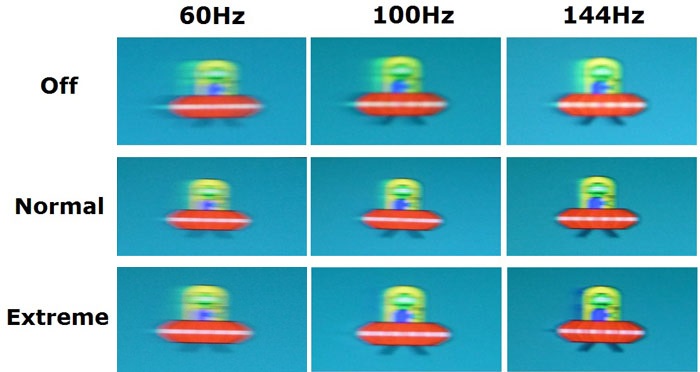
We carried out pursuit camera tests under each of
the 3 OD (overdrive) settings, and at 3 different refresh rates between 60Hz and
144Hz. These tests can give you a good idea of actual perceived motion blur in
practice on the monitor.
With OD first of
all turned off there is a significant amount of motion blur
perceived by the user when tracking moving objects across the screen. The pixel
response times come in to play here as well as the refresh rate. With OD off at
60Hz, the response times were pretty slow with a 12.2ms G2G average recorded
with our oscilloscope. This manifests itself with a significant motion blur in
practice. Switching up to 100Hz and then 144Hz brings about positive changes in
response times when OD is off and with the higher refresh rate. By the time you
are running at 144Hz with OD off, the average G2G figure has improved to 6.9ms.
The blurring is reduced at higher refresh rates (OD off) as a result of both the
improved response times, and the improved refresh rate.
Switching the OD
setting up to the optimal 'normal' mode, there are noticeable improvements in
response times (measured earlier) and in resulting motion blur. At all refresh
rates there is a marked improvement in blur compared with OD off, as you would
expect. We had measured a consistent 2.9ms average G2G response time with OD
normal at all refresh rates. As you increase the refresh rate with OD set to
normal the blurring is reduced each time. It is not eliminated entirely due to
the nature of the sample-and-hold LCD display and the tracking of your eyes.
No matter how fast
the refresh rate and pixel response times are, you cannot eliminate the
perceived motion blur without other methods (which is where ULMB comes in).
With OD set to the
maximum 'extreme' setting there is again an improvement in blurring as you
increase the refresh rate. We had measured a consistent 2.4ms G2G average
response time at all refresh rates in this mode, but you can see that some of
the overshoot artefacts become clear by the time you reach 144Hz. There is a
dark halo behind the moving object which is distracting. Remember also that
these UFO tests are only testing a few sample colour transitions, but we had
measured some significant overshoot across many different G2G changes with OD
set to extreme. We will reiterate that OD normal is optimum on this screen.

ULMB Enabled (PW = 100)
We left the strobe
pulse width length at maximum setting here as it has an impact on brightness if
you lower it, in an attempt to reduce motion blur even further. We felt the
results were very good without needing to reduce the strobe length anyway here. With ULMB enabled the backlight is
strobed briefly, once per refresh, for low persistence. The brief backlight
flash prevents tracking-based motion blur and the moving object is far easier to
see when tracking it across the screen with your eyes (or by the pursuit camera). There is extremely little leftover ghosting caused by pixel transitions
(virtually invisible to the human eye), since nearly all (>99%+) pixel
transitions, including overdrive artefacts, are now kept unseen by the human
eye, while the backlight is turned off between refreshes.
The clarity of the moving image is improved
significantly and tracking across the screen with your eye is much easier and
clearer. You will note there is
some cross talk evident here in the form of the trailing image, and a result of
the strobe timing. These images were taken at the centre of the screen
vertically, so it gives you a good indication also of the strobe cross-talk
levels on this display, in the central region. In the middle
region of the screen it is at low/moderate levels but is not too bothersome in
practice. The cross-talk is reduced as you increase the refresh rate as well
which is pleasing. Again you can see the effects of some overshoot on the Asus
screen with a bright halo behind the moving image being apparent. These tests
give you a good visual indication of the improvements which ULMB can bring in
perceived motion blur.

Additional Gaming Features
-
Aspect Ratio Control -
The PG278Q does not offer any
aspect ratio control options through the OSD menu at all. This is due to a
limitation of using NVIDIA's new G-sync technology. As we understand it, it is
locked to only one defined resolution, in this case 2560 x 1440 so it is not
possible (or easy) to provide G-sync support with a scaler. This isn't really a
problem for PC use since you can just control the aspect ratio through your
graphics card settings. It would be an issue perhaps for external devices, but
since the PG278Q only has one input, you probably aren't going to be using this
screen for anything else anyway (consoles, DVD players etc). It's firmly aimed
at PC gaming use and nothing else, so the absence of a scaler is not a big issue
here. The native 16:9 aspect ratio is of course beneficial since a lot of
content is in this aspect ratio anyway.
-
Preset Modes -
There are no specific gaming preset modes
available in the OSD or other preset modes. If you want different settings for
different uses you may find it difficult, or have to adjust the OSD each time.
It's quite quick and easy to change the brightness setting at least so you could
easily change that if you need to boost it for gaming.


Lag
We have written an in depth article about
input lag and the various measurement techniques which are used to evaluate
this aspect of a display. It's important to first of all understand the
different methods available and also what this lag means to you as an end-user.
Input Lag vs. Display Lag vs. Signal
Processing
To avoid confusion with different terminology we
will refer to this section of our reviews as just "lag" from now on, as there
are a few different aspects to consider, and different interpretations of the
term "input lag". We will consider the following points here as much as
possible. The overall "display lag" is the first, that being the delay between
the image being shown on the TFT display and that being shown on a CRT. This is
what many people will know as input lag and originally was the measure made to
explain why the image is a little behind when using a CRT. The older stopwatch
based methods were the common way to measure this in the past, but through
advanced studies have been shown to be quite inaccurate. As a result, more
advanced tools like SMTT provide a method to measure that delay between a TFT
and CRT while removing the inaccuracies of older stopwatch methods.
In reality that lag / delay is caused by a
combination of two things - the signal processing delay caused by the TFT
electronics / scaler, and the response time of the pixels themselves. Most
"input lag" measurements over the years have always been based on the overall
display lag (signal processing + response time) and indeed the SMTT tool is
based on this visual difference between a CRT and TFT and so measures the
overall display lag. In practice the signal processing is the element which
gives the feel of lag to the user, and the response time of course can
impact blurring, and overall image quality in moving scenes. As people become
more aware of lag as a possible issue, we are of course keen to try and
understand the split between the two as much as possible to give a complete
picture.
The signal processing element within that is quite
hard to identify without extremely high end equipment and very complicated
methods. In fact the studies by Thomas Thiemann which really kicked this whole
thing off were based on equipment worth >100,000 Euro, requiring extremely high
bandwidths and very complicated methods to trigger the correct behaviour and
accurately measure the signal processing on its own. Other techniques which are
being used since are not conducted by Thomas (he is a freelance writer) or based
on this equipment or technique, and may also be subject to other errors or
inaccuracies based on our conversations with him since. It's very hard as a
result to produce a technique which will measure just the signal processing on
its own unfortunately. Many measurement techniques are also not explained and so
it is important to try and get a picture from various sources if possible to
make an informed judgement about a display overall.
For our tests we will continue to use the SMTT
tool to measure the overall "display lag". From there we can use our
oscilloscope system to measure the response time across a wide range of grey to
grey (G2G) transitions as recorded in our
response time
tests. Since SMTT will not include the full response time within its
measurements, after speaking with Thomas further about the situation we will
subtract half of the average G2G response time from the total display lag. This should allow us to give a good estimation of
how much of the overall lag is attributable to the signal processing element on
its own.
Lag Classification
To help in this section we will also introduce a broader classification system
for these results to help categorise each screen as one of the following levels:
-
Class 1)
Less than 16ms / 1 frame lag - should be fine for gamers, even at high levels
-
Class
2)
A lag of 16 -
32ms / One to two frames - moderate lag but should be fine for many gamers.
Caution advised for serious gaming and FPS
-
Class
3)
A lag of more
than 32ms / more than 2 frames - Some noticeable lag in daily usage, not
suitable for high end gaming

For the full reviews of the models compared here and the dates they were written
(and when screens were approximately released to the market), please see our
full
reviews index.
|
(Measurements in ms) |
|
|
Total Display Lag (SMTT
2) |
4.0 |
|
Pixel Response Time
Element |
1.45 |
|
Estimated Signal
Processing Lag |
2.55 |
|
Lag Classification |
1 |
|

Class 1 |
We have provided a comparison above against other
models we have tested to give an indication between screens. Those shown with
blue bars in the bottom half represent the total "display lag" as at the time of
review we did not have access to an oscilloscope system to measure the response
time element and provide an estimation of the signal processing. The screens
tested more recently in the top half are split into two measurements which are
based on our overall display lag tests (using SMTT) and half the average G2G
response time, as measured by the oscilloscope. The response time is split from
the overall display lag and shown on the graph as the green bar. From there, the
signal processing (red bar) can be provided as a good estimation.
The screen showed a total average display lag of
only 4.0 ms as measured with SMTT 2. This remained the same at each refresh
rate. Taking into account half the average G2G
response time at 1.45ms while using the 'normal' OD setting, we can estimate
that there is only ~2.55 ms of signal
processing lag on this screen. This is extremely low and won't represent
any problem for gaming at all. Another excellent result.

Gaming Summary
The overall gaming performance of the ROG Swift
PG278Q was quite frankly pretty amazing! This screen is obviously aimed
completely at gaming, and it won't disappoint. First of all you have the first
2560 x 1440 resolution 27" gaming screen on the market, providing a huge boost
in resolution, image quality and detail compared with current 1080p models. The
support for refresh rates up to 144Hz is obviously a huge benefit as well,
providing smooth, fast and fluid movement and the ability to produce high frame
rates for competitive gaming. Response times were very impressive and fast, and
while there was a little overshoot introduced it shouldn't present any major
problems. The response times of the TN Film panel are fast enough to keep up
with the demand of a higher refresh rate and provide smooth, ghost-free
movement. The increased 144Hz refresh rate helps reduce the perceived presence
of overshoot as well since more frames are refreshing the image on the screen,
meaning any overshoot doesn't linger as long as it would on a lower refresh rate
display.
When you consider that Asus have then provided
NVIDIA's new G-sync dynamic refresh rate technology AND a blur reduction
backlight, you really do have a monster of a gaming screen on your hands (not to
mention also the support for 3D gaming!). G-sync works extremely well,
overcoming many of the problems associated with older Vsync usage. It certainly
is one of the biggest upgrades in a long time when it comes to gaming and
displays. The ULMB backlight worked very well also, offering noticeable and
marked improvements in image quality and reduced motion blur when tracking
movement across the screen. It was well implemented and even offered a useful
control over the strobe length for those who like to tweak things a bit. It has
minimal impact on the colour and appearance of the screen, although you do of
course lose some brightness range. The lag of the display was also pretty much
non-existent which was excellent news, and all in all this stacked up to what we
consider to be the ultimate gaming screen currently.
There are a few slight issues we will address here
as well. The graphics card support needs to be taken into consideration, and you
will probably have to have a high end GPU and system to really benefit from
everything this screen can offer. Given the screen's comparatively high price tag,
we expect most buyers will already be equipped with the system they need. It would
have been nice to see some preset modes available from the screen so you didn't
have to manually adjust things between gaming and regular uses. It's missing
some of the "extras" and bells and whistles that you might find from other
dedicated gaming screens, but the ROG Swift PG278Q is obviously purely focused
on power and performance! We're not sure why the ULMB feature didn't work
at 144Hz as well, that could have been useful.

Movies and Video

The following summarises the screens performance
in video applications:
-
27"
screen size makes it a reasonable option for an all-in-one multimedia screen,
but being quite a bit smaller than most modern LCD TV's of course.
-
16:9
aspect ratio is more well suited to videos than a 16:10 format screen, leaving
smaller borders on DVD's and wide screen content at the top and bottom.
-
2560 x
1440 resolution can support full 1080 HD resolution content.
-
Digital interface supports HDCP for any encrypted and protected content
-
Only DisplayPort connections
available on its own. If you're watching movies from your PC that isn't a
problem, but you don't have the option to connect additional external devices
here. Interface limitations are related to the support of G-sync and the
nature of this panel.
-
Cables provided in the box
for DisplayPort.
-
Moderate AG coating provides reasonably clear images with no major graininess,
and without the unwanted reflections of a glossy solution. Some graininess
apparent as with other TN Film panels, but shouldn't present a problem in
movies.
-
Wide
brightness range adjustment possible from the display, including a very high
maximum luminance of ~385
cd/m2 and a decent minimum luminance
of 52 cd/m2. This should afford you good control for different
lighting conditions. Contrast ratio remains stable across that adjustment
range as well and is high for a TN Film panel. Brightness regulation is controlled
without the need for PWM and so is flicker free for all brightness settings.
-
Black
depth and contrast ratio are strong for a TN Film panel at 918:1 after
calibration. Detail in darker scenes should not be lost as a result.
-
There
is no specific 'movie' preset mode or any other presets available so you will
need to make manual adjustments if you want something different to your normal
uses.
-
Excellent pixel responsiveness which can handle fast moving scenes in movies
without issue. No major overshoot
issues which is good news. Stick with the 'normal' OD setting.
-
120Hz+
refresh rate support allows for stereoscopic 3D content with relevant active
shutter setup from NVIDIA. Viewing 3D movies is possible on this screen as a
result.
-
Viewing angles are limited due to the use of TN Film panel technology. May
cause issues with gamma and contrast shift if you change your line of sight or
have several people trying to see the screen at once. Not really an ideal
technology for movies as a result of this viewing angle limitation.
-
No noticeable backlight leakage which is good, even in darkened room
conditions.
-
Wide range of ergonomic adjustments available
from the stand, allowing you to obtain a comfortable position for multiple
users or if you want to sit further away from the screen for movie viewing.
-
No
integrated speakers or audio connections on this monitor.
-
No
hardware aspect ratio options on this screen, but given the lack of additional
inputs, your graphics card should be able to handle the scaling for you anyway
if needed.
-
Picture in picture (PiP) and Picture By Picture (PbP) are not available on
this model.

Conclusion
We know how excited people
were to get a detailed review of this monitor as quickly as possible, so we decided
to release this as a full review straight away without making it a paid preview
first. If you appreciate the early access to the review and enjoy reading and like our work, we would welcome a
donation
to the site to help us continue to make quality and detailed reviews for you.
Well, has it been worth the wait and the hype for
this display? In a word - yes! As we unboxed the screen we knew straight away
that this was a quality product. The design and aesthetics look sleek,
futuristic and impressive. Little touches like the very thin bezel, red LED
light on the base, joystick OSD control and patterned plastic trim gave it a
premium feel. The stand provided a great range of easy to use adjustments as
well which was pleasing. Powering on the screen provided a sharp and crisp image
with an excellent default setup. We were impressed by the accurate gamma, white
point, colour accuracy and also the strong contrast ratio. The use of a
flicker-free backlight was also excellent news. Keep in mind this is the first
2560 x 1440 resolution gaming screen as well, and you really do get a noticeable
bump in resolution, clarity and desktop real-estate. We've already talked a lot
about the gaming performance of this screen, and we don't want to repeat what
we've already written in the
gaming
summary section. We will just re-iterate that at the moment we feel this is
the ultimate gaming screen. Response times, lag, refresh rate, G-sync and the
ULMB feature all delivered and impressed. Sure, the screen misses some of the
extras you might get from some other gaming screens and it might feel a little
lacking in some options, but what it lacks there it makes up for in raw
performance.
For gaming, this is no doubt an excellent screen.
Obviously there has to be some sacrifices in some areas, such is the nature of
the market. For non-gaming uses the restrictive viewing angles of TN Film panel
technology may still be a pain, but colour critical work or photo editing is in
no way an intended usage of this model. You are missing other connectivity
options, with DisplayPort only being a little limiting. The lack of some options
like preset modes and aspect ratio control were also a bit of a shame. The
uniformity of our sample was also a little disappointing, but probably not an
issue in dynamic content like gaming, and it may well vary from sample to sample
as on most screens.
Overall though the screen delivers what it set out
to. A very impressive gaming experience and truly some new and exciting
technologies which we can only hope are adopted by other manufacturers sooner
rather than later. If you were hoping this was going to be a brilliant gaming
screen, you won't be disappointed!
|
Pros |
Cons |
|
Excellent gaming experience,
low response times and lag. Support for NVIDIA G-sync and new ULMB mode |
Restrictive viewing angles of
TN Film technology |
|
Flicker-free backlight |
Lack of preset modes and some
bells and whistles |
|
Excellent default setup |
Limited connectivity with
DisplayPort only |
|
Check Pricing and Buy - Direct Links
|
|
Amazon USA |
Amazon
UK |
Overclockers UK |
Amazon GER |
Amazon CAN
|
|
TFTCentral is a participant
in the Amazon Services LLC Associates Programme, an affiliate
advertising programme designed to provide a means for sites to earn
advertising fees by advertising and linking to Amazon.com, Amazon.co.uk,
Amazon.de, Amazon.ca and other Amazon stores worldwide. We also
participate in a similar scheme for Overclockers.co.uk. |
|

|
TFT Central Awards Explained
We have two award
classifications as part of our reviews. There's the top 'Recommended'
award, where a monitor is excellent and highly recommended by us. There is
also an 'Approved' award for a very good screen which may not be perfect,
but is still a very good display. These awards won't be given out every
time, but look out for the logo at the bottom of the conclusion. A list of
monitors which have won our awards is available
here. |
|